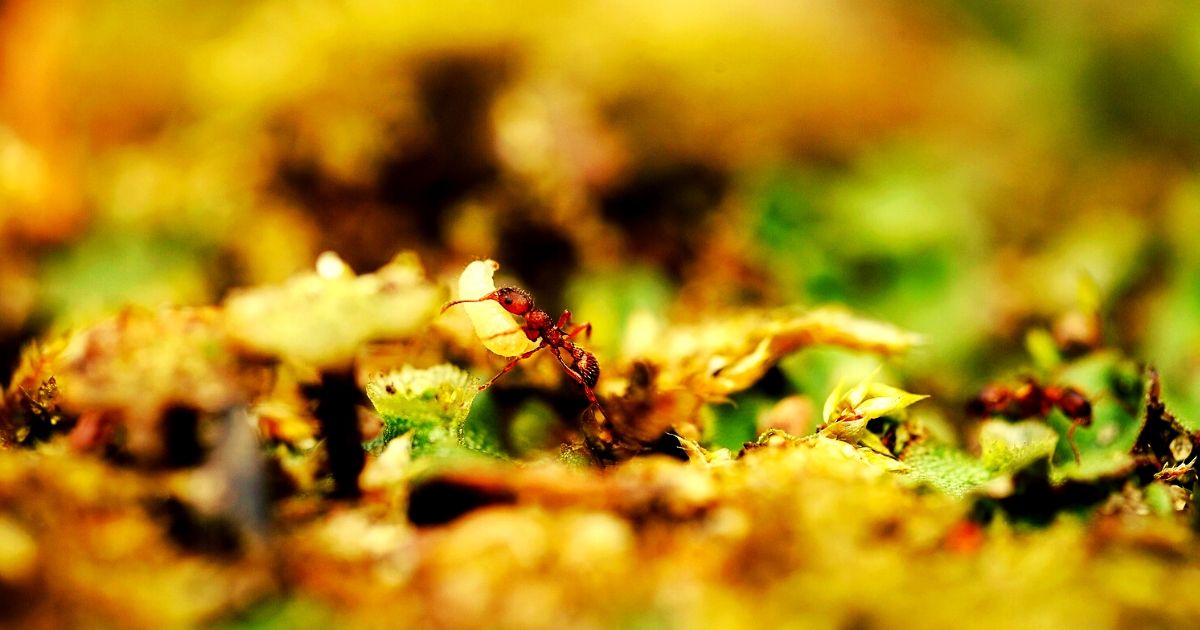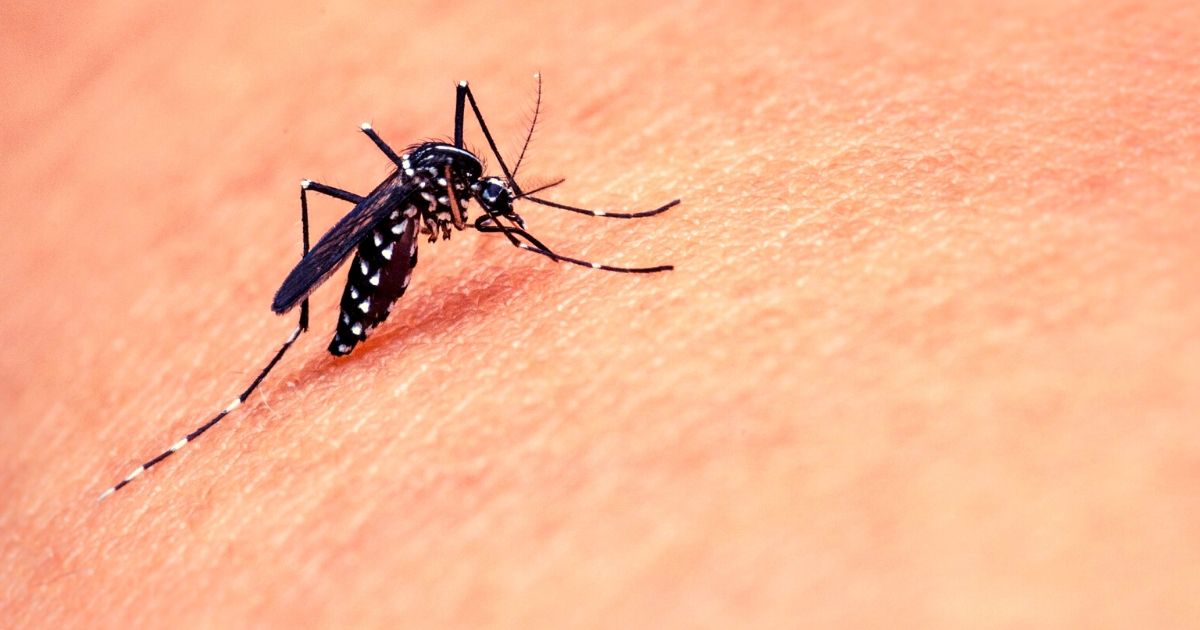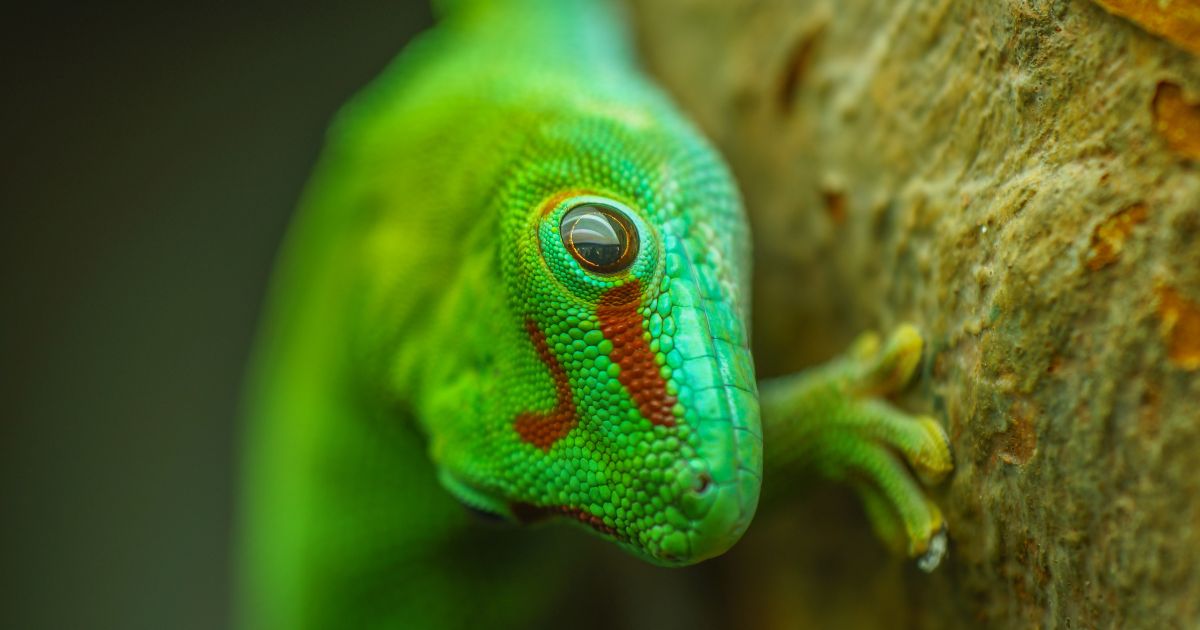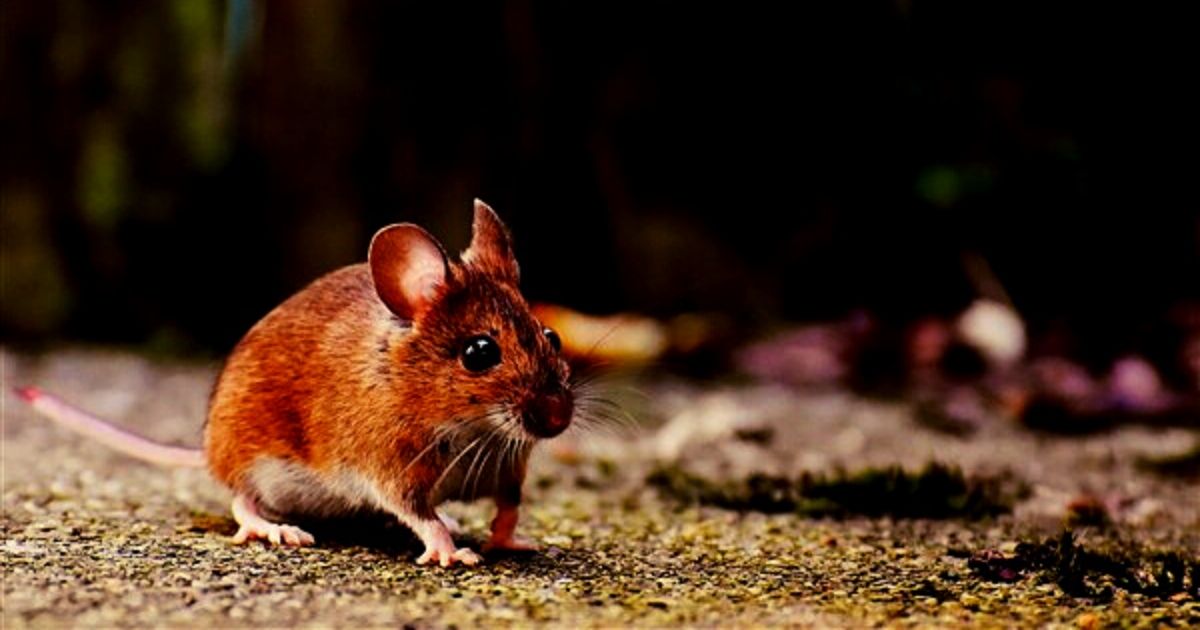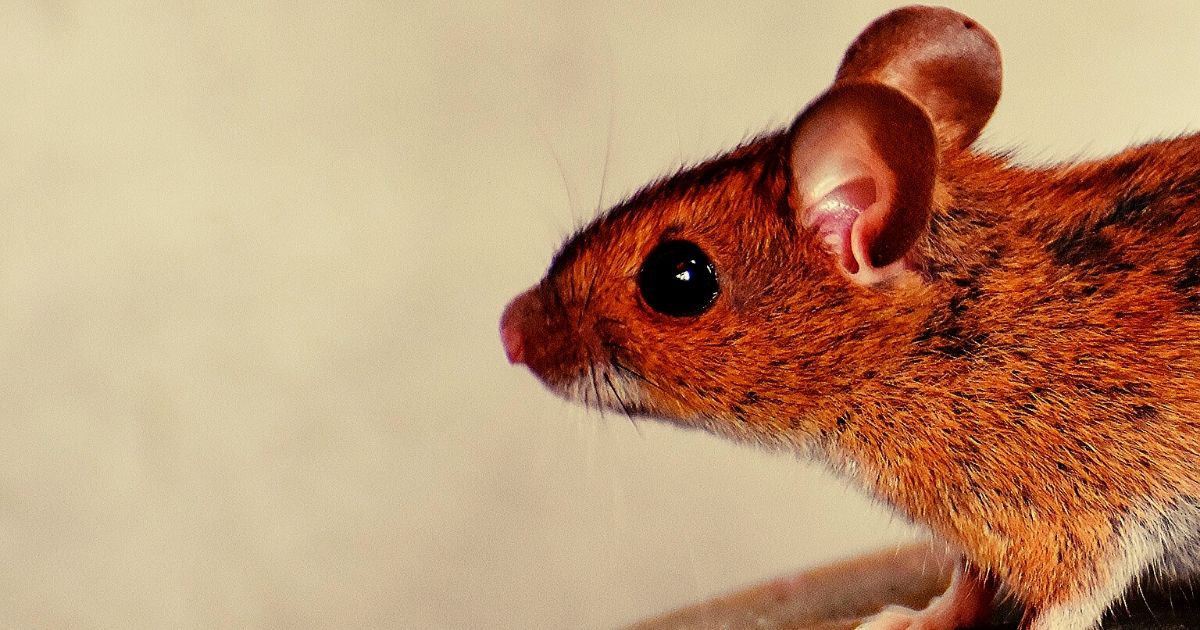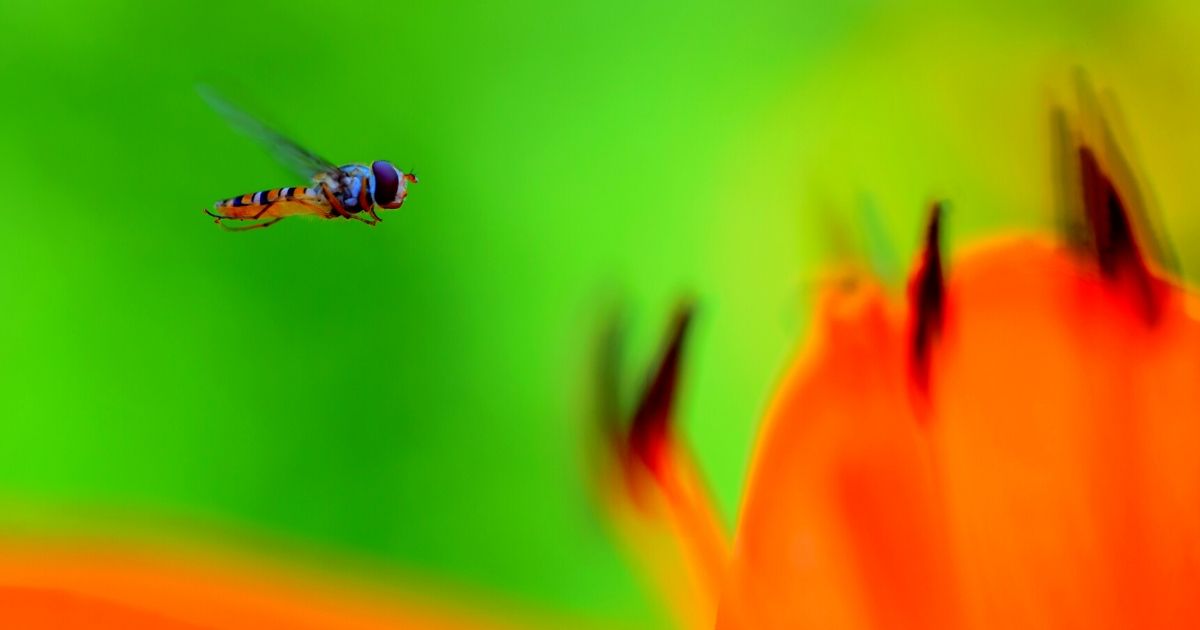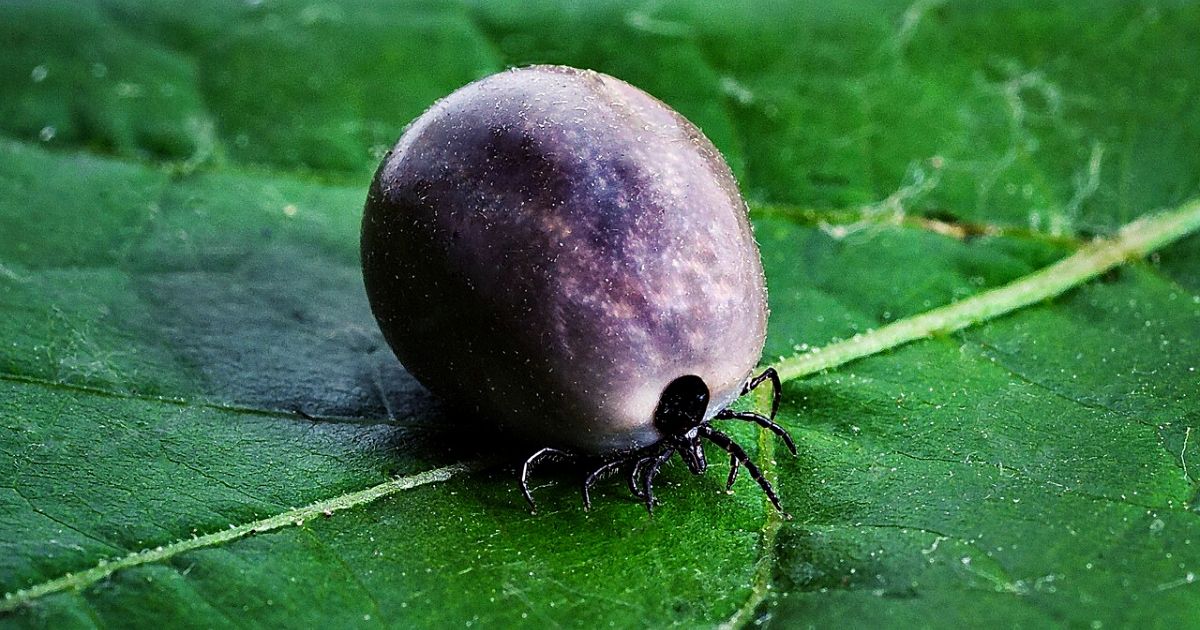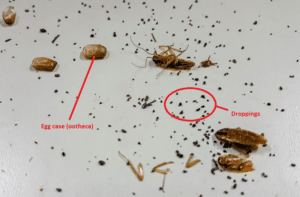The Ultimate Guide to Scorpions
Scorpions are arthropods that are related to spiders. Some features of scorpions are that they have a long tail with a stinger on the end and a set of pincers on the front of the body. In this article, we discuss some interesting and useful facts about scorpions. There are scorpions in Singapore along with other stinging pests such as bees, wasps, and hornets. Scorpions occur in many different types of habitats including deserts, but in Singapore, they are most often found inhabiting forested areas.
Scorpion biology
Scorpions are predators that feed on other small creatures that they come across in the environment. Mostly they prey on insects and tiny arthropods, but larger-sized scorpions may even take small vertebrates such as lizards.
They have a flattened segmented body and jointed limbs. A scorpion also has four legs, a pair of pincers near the head area, and a tail with a stinger. The average size of a scorpion is about 6 cm.
They breed during the warm season or year-round in the tropics. The mating process involves a complex courtship ritual. Scorpions can mate many times and the females have live births. The average number of offspring is 25.
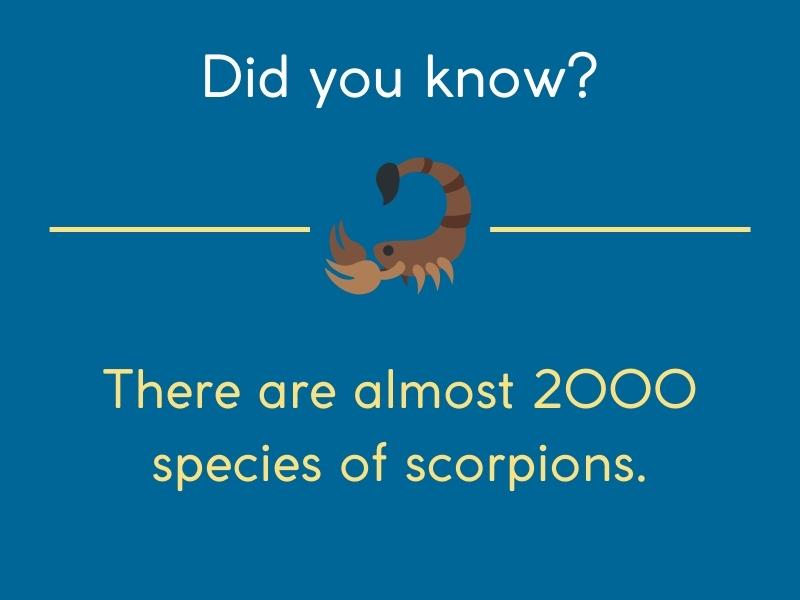
Types of scorpions
There are many different types of scorpions (almost 2000 species of scorpions) found in many habitats around the world. In Singapore, the most important species of scorpions are listed below next to the family name:
Family Buthidae
- Lesser brown scorpion – Isometrus maculatus
- Long-tailed scorpion – Lychas scutilus
Family Chaerilidae
- Chaerilus rectimanus
Family Hemiscorpiidae
- Dwarf wood scorpion – Liocheles australasiae

Do scorpions bite?
Scorpions do not bite normally, instead their defense mechanism is to sting. You should avoid touching and picking up a scorpion because you risk receiving a painful sting that may be harmful to you.
Are scorpions poisonous?
Scorpions are not considered poisonous; however, all species are venomous to some extent. This means that they contain venom in their tail which they inject when they sting someone. The venom of a scorpion is a toxic substance that directly affects the nerves or blood cells. The exact type and potency of the venom vary depending on the specific species of scorpion.
Did you know: Scorpions cause over 3000 human fatalities a year world-wide.
Are scorpions dangerous?
Scorpions can be deadly; they do cause over 3000 human fatalities a year world-wide. However, not all species are dangerous to humans. In many cases, the venom may not be dangerous for people.
There are a few that are more harmful to people. The most dangerous scorpions are in the two scorpion families: Scorpionidae and Buthidae. They are responsible for almost all cases of human injury.
Which are the most dangerous scorpions?
Although Scorpionidae looks more intimidating since they have larger pincers, it is actually the Buthidae that are more venomous, even deadly at times. The Buthidae have smaller pincers and a thicker tail than the Scorpionidae but the venom they produce is much stronger.
Many scorpions do not kill humans when they sting them but the sting can cause pain and swelling. Another concern is the possibility of an allergic reaction that can even lead to anaphylaxis.
The sting of any scorpion could cause anaphylaxis in vulnerable individuals. Anaphylaxis can quickly cause death, so it is best to rather avoid direct contact with scorpions. Even if you have never before had a dangerous allergic reaction it can still happen with any type of sting.
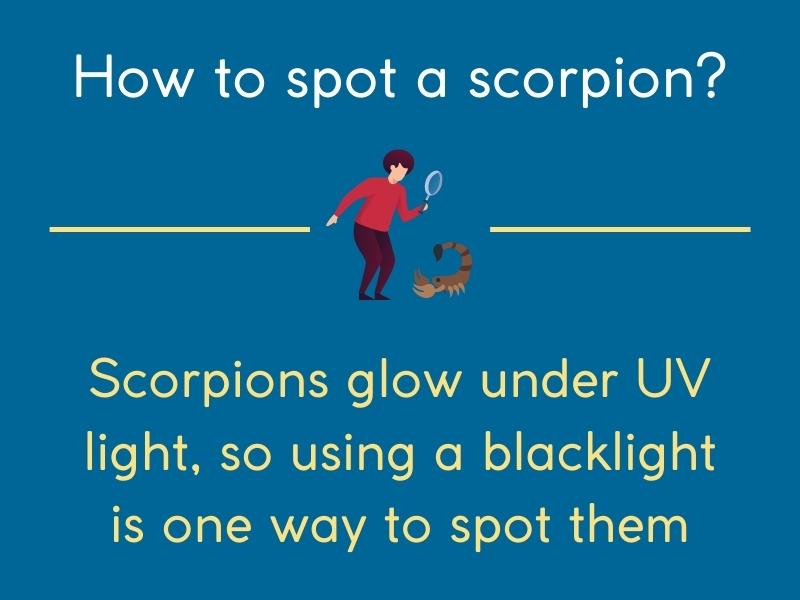
How to spot a scorpion
Scorpions are active at night and many show up under ultraviolet light, so using a blacklight is one way to spot them. They often hide under logs or fallen debris. In houses, you could potentially find them in crawl spaces and attics. Scorpions prefer darkened spaces in dwellings, such as cracks and joints where they can hide out during the day.
How scorpions can enter your home
Scorpions can enter a dwelling through small cracks and holes. These insects are flat-bodied and can even crawl under doors, so having weather-stripping in place is a good idea.
These arthropods are predators that feed on other arthropods including insects like crickets. An infestation of crickets or other insects in your home may attract scorpions looking for food. You may not even know you have a scorpion in the home until you happen to spot one.
It is not common to have many scorpions infesting a home. However, they can be dangerous to people and pets depending on what type they are.
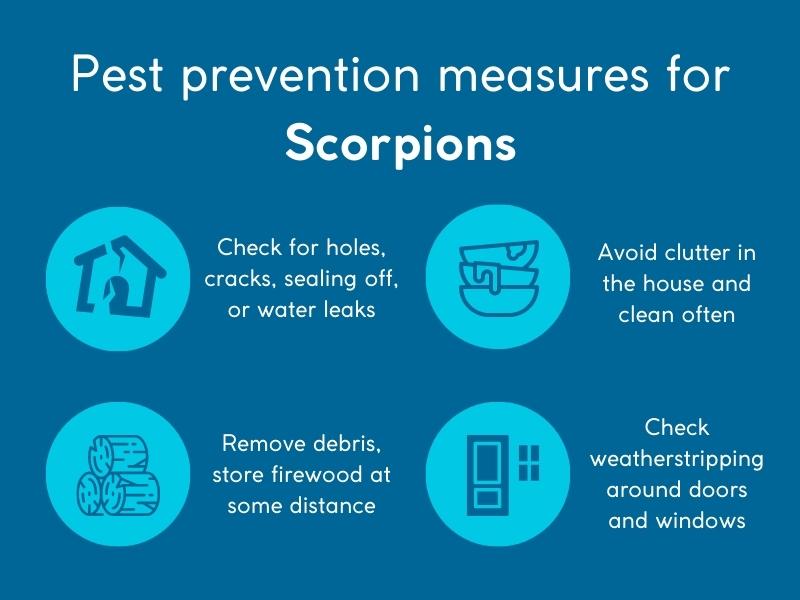
Pest prevention measures for scorpions
- It is better to prevent the entry of scorpions and other small pest insects into the house, to begin with. This can be accomplished by checking for holes and cracks and sealing off and repairing where needed.
- Make sure weatherstripping around doors and windows is in good shape.
- Check for water leaks since this attracts scorpions and other noxious insects like cockroaches.
- Avoid clutter in the house since this provides hiding places for scorpions.
- Clean the house often; this is a good way to notice if there are pests present.
- Remove debris close to the house since this can attract scorpions.
- Make sure firewood is being stored some distance from the house since this also will be attractive to scorpions and other pest insects.
- If you suspect a scorpion may be present, invest in a blacklight and search at night for any signs of the animal. They will glow under UV light and be easy to see.
Pest control measures for scorpions
Scorpions are usually simply directly killed by spraying them with insecticide. Fogging is not required unless you have a big infestation of some other type of pest like cockroaches.
Always be careful using insecticides in the home, especially if you have pets and small children.
Conclusion
Scorpions are arthropods that sting with their tail. The venom of many species is not a big concern to humans but pets and small children are at higher risk. Even though most species will not kill you it is wise to prevent scorpions from entering your home.
Frequently Asked Questions
Although scorpions and insects have some similarities, scorpions belong to the class of animals known as the Arachnids. This makes scorpions a distant relative of spiders.
First, scorpions use their claws to grab the prey; smaller victims get crushed and killed with the scorpion’s grip. Then, scorpions sting the prey with its tail to inject the venom.
Usually scorpions won’t attack people, unless they feel threatened. Their stinging is the defence mechanism against being attacked or getting crushed.
Scorpions are not considered poisonous; however, all species are venomous to some extent. Only some of the species produce the venom that is deadly.
The most dangerous scorpions are in the two scorpion families: Scorpionidae and Buthidae. They are responsible for almost all cases of human injury.
All scorpions will glow in the dark under a ultraviolet (UV) light, also known as a “blacklight”. This is caused by an unidentified substance in their skin.
In addition to deserts, scorpions can also be found in tropical and subtropical environments, such as grasslands, savannas, and forests.
Most scorpions hide under rocks, logs, clutter or boards. This is why you should avoid clutter and debris around and in your house, and make sure there are no holes or cracks for scorpions to hide.
Related Posts
The Ultimate Guide to Monkeypox
Monkeypox is one of the orthopoxviruses that can infect people and cause illness. Prior to 2022, monkeypox was rather limited in distribution, occurring in countries in Central Africa and West Africa. The most recent outbreak started in May 2019 with a single monkeypox case detected in Singapore.
The patient had traveled from Nigeria, where monkeypox is actually endemic. Monkeypox in Singapore has since been confirmed in more patients. A total of 15 men in Singapore have been confirmed as monkeypox cases. Read on to learn more about monkeypox.
Where Did Monkeypox Come From?
Monkeypox was first identified in the 1970s in the Democratic Republic of Congo in Africa. The belief is that the virus spread from a mammal to a human at some stage. Monkeypox is, therefore, called a sylvatic zoonosis since the virus has spread from a natural animal host to humans.
Monkeypox can occur in a variety of mammals including rats, shrews, squirrels, hedgehogs, and anteaters. Scientists suspect that the virus was at some stage transmitted from a rodent to a human.

Monkeypox Symptoms
The signs of monkeypox appear anywhere from 7 days up to 21 days after exposure to the virus. Not all the symptoms are present in every infected person. The person stays contagious for up to a month when all the pustules should have scabbed over and fallen off.
The symptoms of monkeypox include the following:
- A rash that occurs on the face, chest, hands, and genitals. The rash consists of vesicles that form blisters. The vesicles can be itchy and also very painful.
- Fever of more than 38°C
- Chills
- Headache
- Swollen lymph nodes
- Muscle pain
- Respiratory signs such as a cough, a sore throat, and a stuffy nose
Complications of Monkeypox
There are some dangerous complications that can occur in people who have monkeypox. These complications are listed below.
- Encephalitis
- Bronchopneumonia
- Corneal infection that can lead to blindness
- Death
Monkeypox can lead to death in anywhere from 1% to 10% of cases depending on the country where the outbreak occurs. The average worldwide death rate for monkeypox is about 3% to 6%. Individuals who have a compromised immune system, infants, and children are especially susceptible to severe illness and complications.
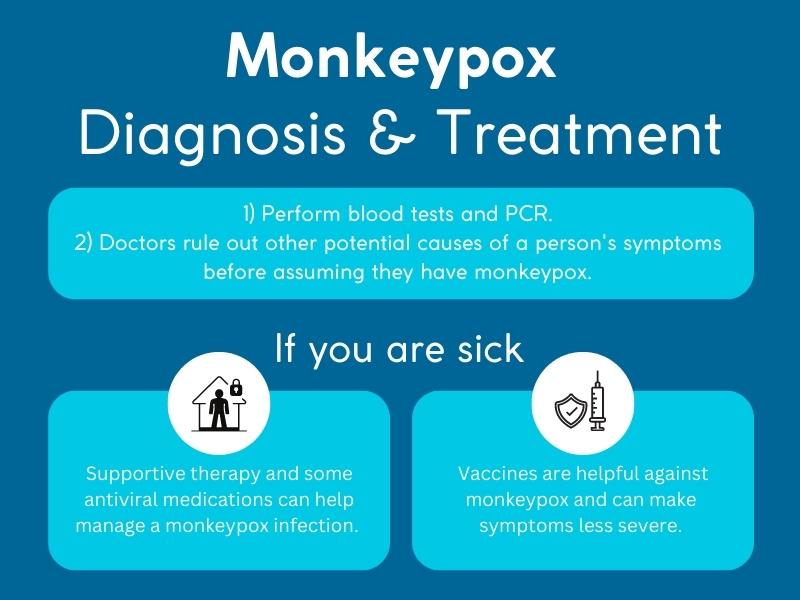
Monkeypox Diagnosis
Diagnosis of monkeypox is usually by blood tests and PCR. PCR is the best way to detect the virus and is better than immunology tests looking for antibodies. The infection is still less common than other rash-producing illnesses so doctors need to eliminate other potential causes of a person’s symptoms before assuming they have monkeypox. Travel history of the person and contact with individuals already diagnosed with monkeypox raises the level of suspicion that the person has the monkeypox infection. Molecular tests such as PCR can confirm the diagnosis, as previously mentioned.
Monkeypox Treatment
Treatment is difficult since monkeypox is caused by a virus, which means antibiotics will not work. Supportive therapy and some antiviral medications can help manage a monkeypox infection. The antiviral tecovirimat has been used to treat some cases of monkeypox.
Supportive therapy includes giving patients fluid and helping them keep their nutrition up. Many people do recover after a few weeks.
There are at least two vaccines that are somewhat helpful against monkeypox and can make symptoms less severe. The Ankara vaccine was developed for monkeypox in 2019 but it is not always easily available.
Pro Tip: The best way to prevent monkeypox is by avoiding close contact with infected areas, people or animals.
How Monkeypox is Transmitted
People can catch monkeypox from eating uncooked bushmeat. A person can also become infected if bitten or scratched by an animal that is infected with monkeypox.
Transmission among people is by close physical contact. The virus spreads by contact with:
- body fluids such as saliva, semen, blood, fluid from blisters, and urine
- the monkeypox skin lesions
- articles of clothing and linen used by the infected person
- respiratory droplets
The virus can also spread from a mother to her fetus. This has resulted in fetal deaths.
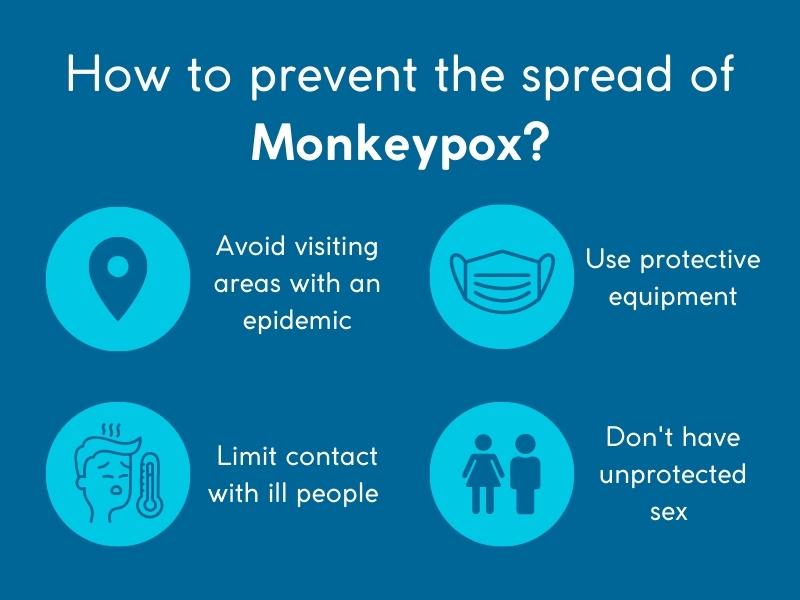
Monkeypox Prevention
You can prevent catching monkeypox by following some simple rules outlined below.
- Avoid visiting areas where monkeypox is endemic, or if unavoidable, take extra precautions in those countries.
- Avoid close contact with people currently ill with monkeypox.
- Do not have unprotected sex because this is one way the disease is spread among people.
- Health workers need to use protective equipment and take care to avoid infection when treating people who are sick with monkeypox.
Conclusion
Monkeypox is a serious illness that can result in death. The symptoms are similar to many other illnesses meaning that diagnosis may be difficult initially. There are also limited treatment options for monkeypox, which is why your best strategy is to try to prevent becoming infected in the first place.
Frequently Asked Questions
Rodents are thought to be a likely natural reservoir of the monkeypox virus. This means that the virus is quite commonly found infecting rodents.
Rodents can and do transmit monkeypox. In fact, the presence of monkeypox in the western hemisphere has been linked to infected rats that came from Africa. In the United States, a past outbreak occurred when rats imported from Africa infected prairie dogs. People then became infected when coming into contact with the infected prairie dogs.
Since rodents do carry monkeypox, pest control methods can potentially help decrease the chance of getting infected by eliminating rodent pests in the home.
There is not currently a vaccine that is only for monkeypox, however, people who have had the smallpox vaccine may have some protection from monkeypox since the viruses are similar in structure. There is also a vaccine called the modified vaccinia Ankara (MVA) vaccine, which can be used for both smallpox and monkeypox.
Monkeypox has not yet been classified as a pandemic although it is found in more than one country. So far, as of late July 2022, over 9000 cases have been reported from 63 countries.
Though closely related to smallpox, monkeypox is not nearly as contagious. This illness is also not as severe as smallpox.
Monkeypox has an R0 number of about 1.5 to 2.4, varying from place to place. The R0 number indicates how many people a sick person is likely to infect. Unlike measles which had a large R0 number of 12 to 18, monkeypox is not highly contagious.
Scientists recognize two strains of monkeypox: one is a Congo strain, and the other is a West African strain.
Related Posts
The Ultimate Guide on Centipedes and Millipedes
Pest Guides

Table Of Contents
- What are Centipedes and Millipedes?
- What Is the Difference Between Centipedes and Millipedes?
- Biology of Centipedes
- Biology of Millipedes
- Signs of a Centipede or Millipede in the House
- How to Prevent Centipedes and Millipedes From Entering Your Home
- How to Get Rid of Centipedes?
- How to Get Rid of Millipedes?
What are Centipedes and Millipedes?
Centipedes and millipedes are both invertebrates but not insects. They are arthropods which have a hard exoskeleton and multiple legs. They are invertebrates that are most often found in damp conditions under leaf litter and in the soil. Usually, they don’t enter homes, but can be attracted to the moisture and warmth found inside a house.
These arthropods are not major pests but can become a nuisance, which is why we have also included a discussion on how to get rid of centipedes and millipedes.
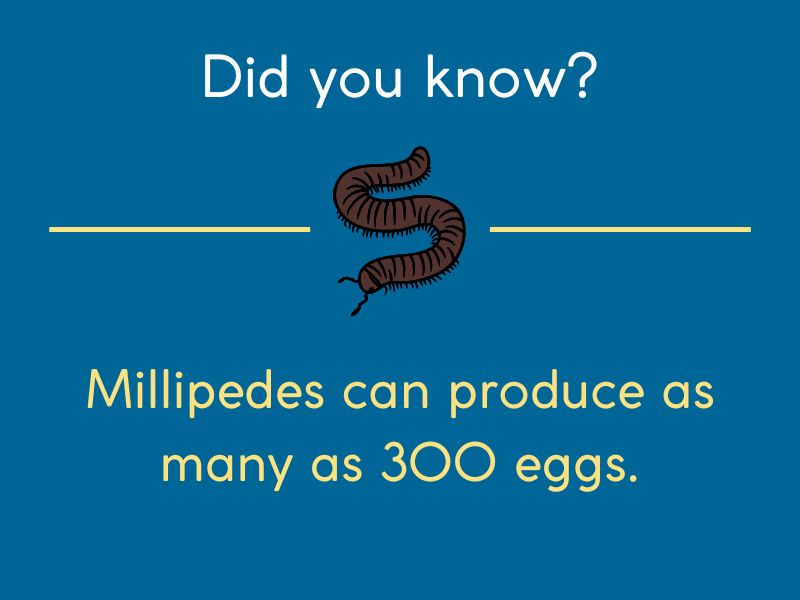
What Is the Difference Between Centipedes and Millipedes?
Although similar, centipedes are not the same animals as millipedes. They differ in appearance, feeding habits, and amount of movement.
You may be wondering what do centipedes and millipedes look like? Centipedes have a flatter body while millipedes are rounder.
This is not the only difference between the two because centipedes also have only one leg per segment on the body compared with millipedes which have two legs per segment. The feeding habits and even how active these inverts are is also different.
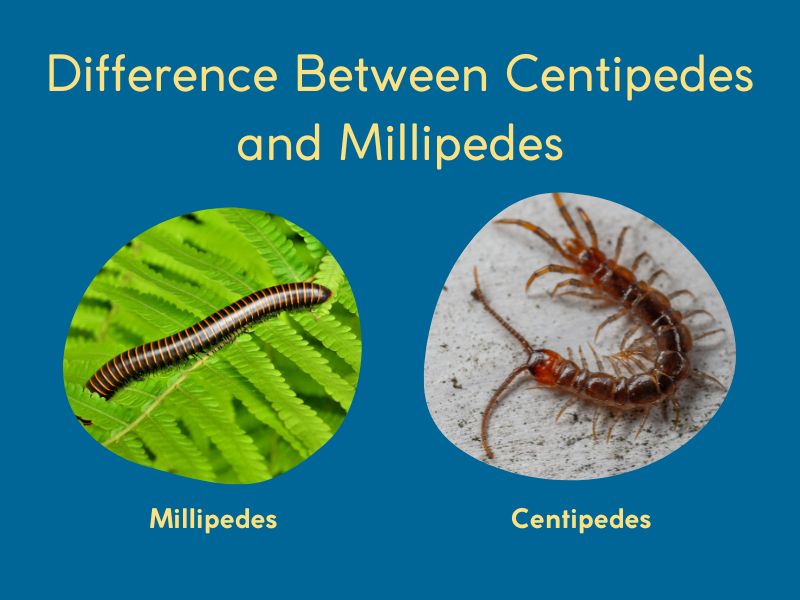
Biology of Centipedes
Centipedes are predators that can run quite fast to catch prey and escape from danger. Centipedes are predacious, feeding on other small insects and arthropods; they also move quite fast and readily hide. They are commonly found when you pick up a rock or disturb leaf litter. While most centipedes cannot hurt you there are a few species that can bite if they feel threatened.
Centipedes either lay eggs or bear live young depending on the species. If they lay eggs these are deposited in the soil during the warm season. The babies hatch from the eggs and look like the adults but are very small. In time they molt and grow until they reach adult size. They can live up to 6 years.
Biology of Millipedes
Millipedes feed on plant matter, decaying material, and on organic matter found in the soil and under leaf litter. These inverts are scavengers and do not actively hunt so they do not move fast like centipedes and instead will curl up into a ball when threatened.
Millipedes do lay eggs. They can produce as many as 300 eggs which hatch in a few weeks into tiny millipedes that eventually molt into the adult form. The millipedes can live a few years.
While millipedes do not bite, they do produce a chemical that is toxic but only serves as an irritant when it comes into contact with human skin.
Signs of a Centipede or Millipede in the House
Unlike other arthropods like cockroaches, there will not be many signs that you have a centipede or millipede in the house. Usually, the only sign of one of these arthropods is seeing the actual animal inside.
There have been stories of centipedes and millipedes in Singapore, including a story of a lady who was bitten by a centipede. They, therefore, can be a nuisance in the home, along with millipedes. In general, these insects are really just a nuisance and not harmful unless they come into close contact with people or pets in the home.
How to Prevent Centipedes and Millipedes From Entering Your Home
It is very unlikely that you will have a centipede and millipede infestation in your home because they really do not normally try to enter a house or dwelling. However, during dry conditions it is possible that these arthropods will find themselves inside a house because they look for moisture. A change in weather is one of many possible causes of centipedes and millipedes entering the home.
Centipedes and millipedes cannot survive in very dry conditions and will actively seek out moist warm conditions; this can mean that they crawl inside through gaps or small openings near the base of your house.
We have listed some centipede and millipede prevention tips below to help you prevent centipedes and millipedes from entering your home.
- Check weatherstripping and caulking to make sure these have not deteriorated leaving spaces through which pests can enter.
- Seal any gaps or cracks that could allow arthropods to enter your home.
- Fix any leaking plumbing fixtures including pipes and faucets that may be dripping.
- Use a dehumidifier or other means to dry out your house.
- Remove any leaf litter that may be right next to the house.

How to Get Rid of Centipedes?
You may wonder how you can rid yourself of centipedes in your house. The first step is to make sure you do not have any damp areas around. Fixing any leaking pipes or faucets can help. Dry out areas of the house where there is dampness.
You can also inspect and directly remove any centipedes that you come across but remember that some species do bite so perhaps use tweezers to pick up any you find. Control measures can include using pesticides but this can be tricky if you have pets and small children in the house, and is best left to a professional pest control treatment.
Pro Tip: It's best to get advice from pest control professionals if you are concerned about centipedes or millipedes in the house and how to treat them effectively.
How to Get Rid of Millipedes?
You can use a similar approach to getting rid of millipedes. Removing moisture and checking under boxes and in dark corners can help you find millipedes. Millipedes do not move fast so they are fairly easy to catch and remove. However, they do secrete substances that can be irritating so perhaps wear gloves if you choose to physically pick up and remove these arthropods yourself.
Consulting a pest control specialist is a good idea if you are concerned about centipedes or millipedes in the house. They will also be able to advise you on which pesticides to use or if fumigation is needed.
How to prevent centipedes and how to prevent millipedes from entering the home means making sure that conditions are not favourable for them. Even though millipedes and centipedes are mainly just a nuisance and not usually major pests, the presence of these arthropods can mean that other worse pests are also able to enter your home.
Frequently Asked Questions
Centipedes’ bites can be quite painful for people as they use their venom as a defense mechanism. Although typically not fatal or dangerous, their bites can hurt, especially when centipedes are large.
Millipedes are not venomous or poisonous, although their defensive spray contains fluids that may cause allergic reactions in some individuals.
Unlike centipedes, millipedes do not bite or sting. They usually produce a fluid that keeps the predators away.
Related Posts
The Ultimate Guide to Booklice
Pest Guides

Table Of Contents
- What are Booklice?
- Life Cycle
- Where Do Booklice Come From?
- Do Booklice Bite?
- Damage Caused by Booklice
- How to Prevent Booklice?
- Signs of a Booklice Infestation
- Booklice versus Bed Bugs
- How to Get Rid of Booklice?
What are Booklice?
Booklice are tiny insects only about 1 to 2 mm in length. They are soft-bodied insects classified in the insect family Psocidae. Booklice in Singapore can be a nuisance as they are often found indoors in peoples’ houses or offices.
Further booklice facts are that they are also called psocids and are not actually lice. Booklice are white or brown in colour and may or may not have wings depending on the particular species. Most of the time booklice you find inside will be the wingless species.
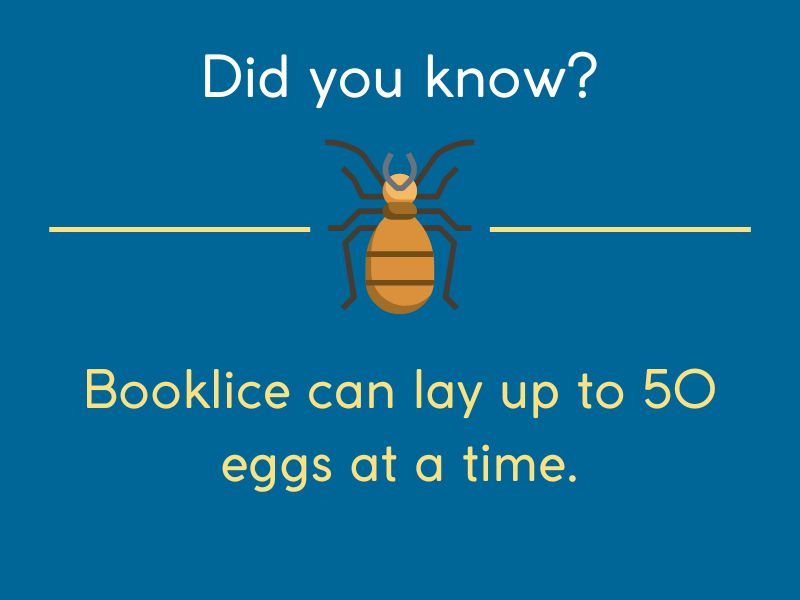
Life Cycle
There is no pupal stage in the development of booklice because they are one of the more primitive types of insects. They pass through an egg, larval, and adult stage during their life. The larval stage looks like a miniature adult and molts as it grows.
They can lay up to 50 eggs and can complete development in 4 weeks. However, in colder temperatures, this insect takes about three times as long to finish development.
In suitable conditions, booklice can produce multiple generations a year and can grow to large numbers without you even realizing it.
Where Do Booklice Come From?
Booklice are found in humid areas, and in nature, you often find them under bark or in leaf litter. They can get into the home through the tiniest of gaps or spaces.
Another one of the causes of booklice getting inside is when people carry in firewood from outdoors or bring home books or other items from a second-hand shop or from long-term storage where mould and mildew have developed.
They like moist conditions so you can expect to find more booklice if the conditions in your home are on the humid side. They will often inhabit moist and dark areas where they may not be noticed.
Pro Tip: The best way to prevent booklice is to eliminate the moisture in your home and seal the cracks and gaps where booklice may be entering.
Do Booklice Bite?
Booklice do not bite and are small insects that may not be easy to detect. They feed on starchy substances and also mould and mildew. They are considered pests because they like to chew up the glue used in book bindings and they do sometimes get into stored food items.
The presence of booklice may also mean that conditions are favourable for other pest insects like silverfish and cockroaches.
Damage Caused by Booklice
Psocids are not as damaging to property as some other pest insects are but they are nonetheless a nuisance. They do chew up the glue in books, meaning that the book pages may come undone. Over time this weakens the books and pages may fall out.
Occasionally you may find booklice inside food like your cereal and other grain products. This is annoying and a person usually won’t want to eat food that has living insects crawling in it.

How to Prevent Booklice?
Booklice enjoy humid and warm conditions, which is why a good strategy is to make sure your home is not overly humid. Below we have included some useful booklice prevention tips to help you stop an infestation from occurring.
- Using a dehumidifier can help to remove excess moisture in the air and you should also check that there are not any leaking faucets or pipes in the bathroom or kitchen area.
- Vacuum and dust often and avoid accumulating clutter which makes it hard to notice when there is a pest problem. This is true for all pest insects that can invade your home.
- Another good strategy is to increase the ventilation of air throughout the home. Open doors and windows during the day on dry and warm days. This can help moisture to evaporate.
- Use airtight containers to store your food in to prevent pests like booklice from gaining access.
Signs of a Booklice Infestation
You may wonder how to spot booklice? There are some signs that you can look for that may indicate a booklice problem. You may notice tiny insects moving in your flour or cereal. These could be booklice. You may also notice a tiny insect scurry out from between the pages of a book.
It is wise to frequently check for any signs of insect damage or the presence of insects. When checking for booklice, you should look in closed drawers and humid areas, and also open a few books up to see if there are any booklice running around.
In general, booklice are difficult to detect because they are so small. The darker-coloured booklice usually are easier to spot because they are darker and will show up against light surfaces.
Booklice versus Bed Bugs
One mistake people may make is confusing booklice with bedbugs, which is why we have included a brief summary of how these two insects differ.
Booklice can be misidentified as bed bugs because both are tiny insects that people may come across in their home. There are some differences though that are described below.
- Booklice have a large head relative to the size of the body
- They will be found in books and on stored products while bed bugs occur on beds and furniture like sofas.
- Booklice are skinnier, in other words, the body is not round and oval the way a bed bug is.
- If you have a bed bug infestation you will quickly know it because you will have bites and notice stains on the bed. This is not the case with booklice.
The Ultimate Guide to Bed Bugs Prevention, Treatment and Control in Singapore

How to Get Rid of Booklice?
Getting rid of booklice involves a few methods. One of the most effective is to decrease the humidity in the home. We have already mentioned that dehumidifiers are a smart idea when you live in a very humid climate.
It will not be feasible or even practical to search for and individually find booklice and kill them. They are far too small and the booklice nymphs are even smaller and will likely not be noticed, the same for the eggs.
If you do have a booklice problem then consulting with insect pest experts is a good decision to make. They can use hot steam and pesticides to kill booklice.
Even though booklice are not major pests, you should still take an infestation seriously because they are a nuisance that can damage your books and infest your food.
Frequently Asked Questions
No, they are harmless to humans and pets. They don’t bite, spread disease, or damage your home. If you’ve noticed bites or stains on the bed, you might have a bed bug infestation.
Although not harmful to humans, booklice can sometimes be causing allergies. Removing the infestation can help to reduce the symptoms and feel better.
Booklice are attracted to areas with high humidity. They feed on starchy substances and also mould and mildew.
Hot steam and pesticides are effective solutions to kill booklice. To get rid of booklice, you will also need to decrease the humidity in the home.
Related Posts
The Ultimate Guide to Silverfish
Pest Guides

Table Of Contents
- What Are Silverfish?
- Life Cycle of Silverfish
- Where Do Silverfish Come From?
- Do Silverfish Bite?
- Damage caused by Silverfish
- How to Prevent Silverfish?
- Signs of Silverfish Infestation
- How to Get Rid of Silverfish
- How to Kill Silverfish?
What Are Silverfish?
Silverfish are small, primitive insects that have a tapered body with three “tails” at the end of the abdomen. The body is silvery gray in color and they have a scaly fish-like appearance. The body size of these insects is only up to 2,5 cm in length.
Further silverfish facts include that there are at least 120 types of silverfish found worldwide and they are believed to have evolved over 400 million years ago. The silverfish cannot fly and are most active at night when you may see them running about behind a book or in a drawer that you open.
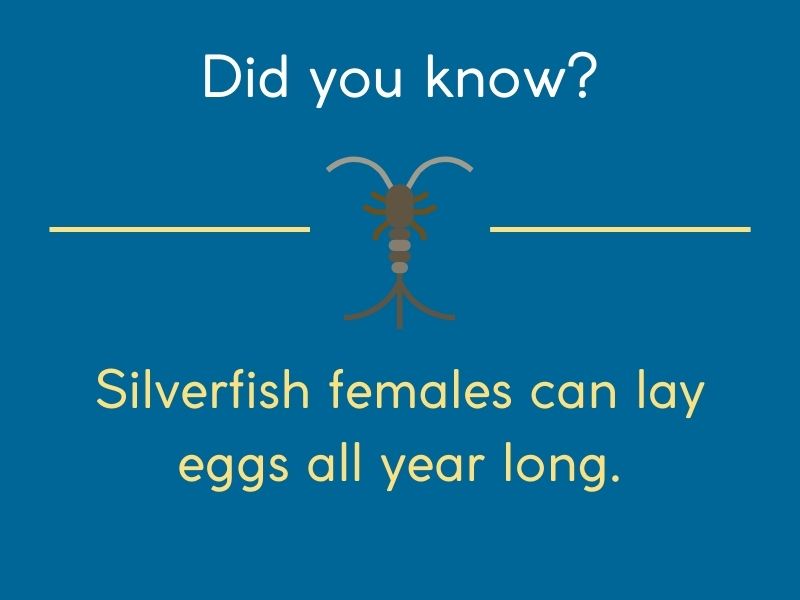
Life Cycle of Silverfish
The silverfish mate and lay eggs in areas like cracks and crevices where they are protected. They can lay up to 20 eggs and complete total development in 4 months. Silverfish females can lay eggs all year which means you can end up with a big problem.
The young silverfish look like the adults when hatching but are small in size. They grow and moult until reaching adult size.
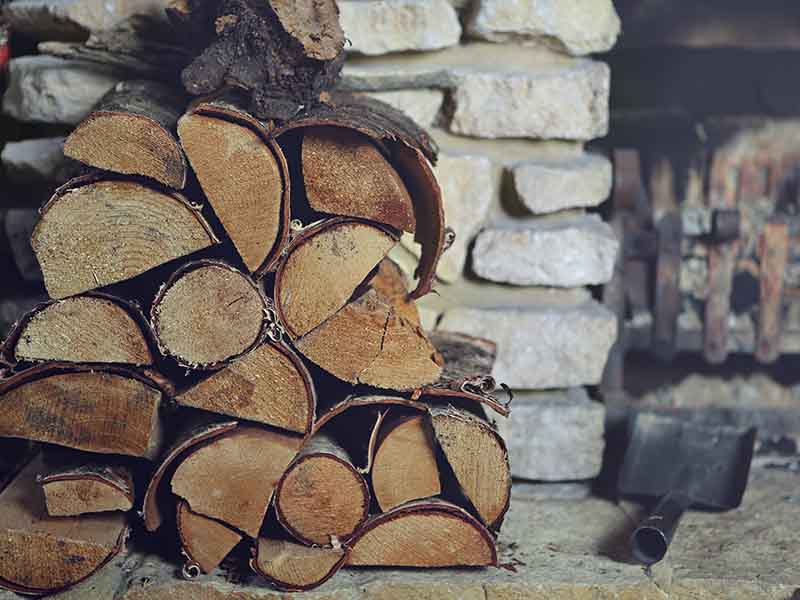
Where Do Silverfish Come From?
These insects are found living in moist and dark places such as under logs, bark, or leaf litter. They can enter houses and other dwellings where they will move into similarly dark and humid places. Silverfish often enter a home through gaps and cracks.
You may accidentally introduce silverfish into your home when you bring home books and other items from a second-hand bookshop or from a storage facility. Silverfish in Singapore occur in homes and other dwellings, where they can cause damage.
Do Silverfish Bite?
Silverfish do not bite but they do cause damage, especially to books and fabrics. Although these insects do not bite, they can cause an allergic reaction in some people. In fact, children with asthma may be sensitive in some cases to allergens released by these insects. The allergens may be the proteins associated with the shed skin of the silverfish or even their faeces.
Damage caused by Silverfish
Silverfish don’t chew up wood like termites do but they nonetheless are a pest because they like to eat starchy substances.
They have tiny mouths but the silverfish over time causes damage to a variety of surfaces including clothes. Eventually, you will start to find some clothes with little holes in them or that appear to have deteriorated.
The silverfish is a particularly big problem when you store items for a long time. These insects will reproduce and soon you will have dozens of silverfish eating away at all your fabrics, clothes, and paper items.
Silverfish often chew up the pages of books and other paper-based materials. You may find important documents and pages of your favourite text with little holes in them because of these insects.
The silverfish also like to eat sugar and bits of dried food so any food that is not properly stored may be targeted for a meal.
How to Prevent Silverfish?
Since silverfish like moist conditions, it is helpful to fix any leaking faucets or other damp areas of the home. A dehumidifier can also help to remove excess moisture and dampness from a dwelling and from cupboards.
Check the weatherstripping and make sure to fix any cracks or gaps you find around the house. Check that any area of caulk has not deteriorated leaving small holes that silverfish and other insects can crawl through. This can help prevent silverfish from getting into the house.
Cleaning the house regularly is important. Vacuum and dust often and keep all food stored in proper containers. Clothing and books should also be checked often for any signs of damage.
Pro Tip: Ensuring a low level of humidity and keeping your home clean and organized will help to prevent silverfish.
Signs of Silverfish Infestation
There are some indications that you have a silverfish problem. We have listed these below:
- Droppings. These may be hard to see because they are so small, but if you notice little black specks around books or in drawers; this could be a sign that silverfish or at least some pest insect is present.
- Live animals. You are very likely to disturb a silverfish when you move a book or clean out a drawer or move clothes around in the closet.
- Yellow staining on belongings. Book pages may show yellow-colored stains, which could be due to silverfish shedding their skins.
- Holes or chewed areas on belongings. Although small in size, silverfish do chew books and other items leaving fine, tiny holes, or damaged edges. These feeding marks are the main causes of silverfish damage.
How to Get Rid of Silverfish
Once you discover you have a silverfish problem, the next steps are to begin control. Getting rid of silverfish is important to stop further damage from happening.
While you can search for and try to kill silverfish on your own and it is unlikely you will find every single individual since they often hide in cracks and crevices. This is also tedious and time-consuming so it may be best to consult a pest control company to help with the problem.
How to Kill Silverfish?
There are traps you can use to catch silverfish, such as glue traps. You can also spray insecticide directly on the insect or fumigate. It is tricky to find and trap or even spray every silverfish in the house because they hide and are difficult to detect.
This is why consulting a pest control specialist may be a good idea. Fumigation is an option if you have a big problem with silverfish and particularly if you have other pest insects like cockroaches that are present in large numbers. Always consult a professional if you are considering fumigation.
Traps and even spraying insecticide may be dangerous if you have pets and small children in the house, this is another good reason to consult with a pest control specialist.
Silverfish are ancient insects that are difficult to notice until they cause damage, which is why checking regularly for signs of a silverfish infestation is important in preventing future problems in the home.
Frequently Asked Questions
Silverfish don’t bite or sting, are not poisonous, and are considered harmless to humans. But they can damage your belongings and contaminate your food, and in some cases, cause an allergic reaction.
Silverfish can be found almost anywhere in the house, usually in dark and damp places. They come into the house through cracks and holes in the building exterior. Silverfish can also lay eggs in those cracks or contaminated belongings.
Silverfish are attracted to high humidity, moisture, and damp conditions. Homes with poor ventilation are prone to silverfish infestation.
Silverfish can eat almost anything, including money, books, clothes, grains, vegetables, fibers, cereals, sugars, and starches.
Washing your clothes at a high temperature can help kill silverfish and their eggs in your clothes. But pay attention to the highest temperature the material allows.
Related Posts
The Complete Guide to Wasp Prevention, Treatment and Control in Singapore
Pest Guides
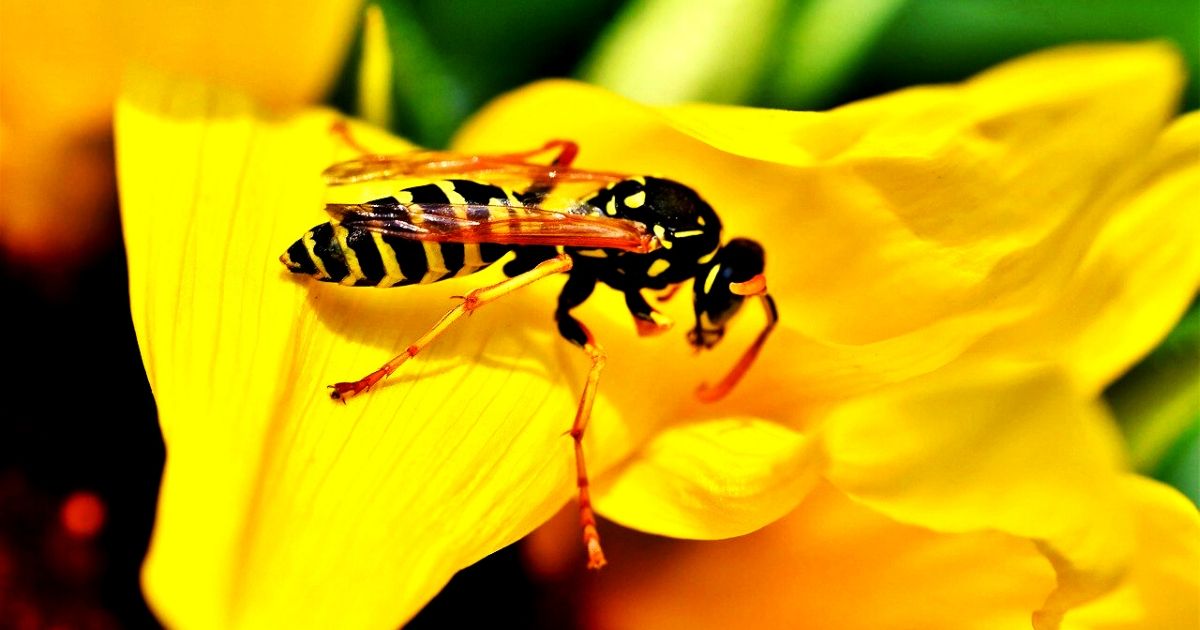
Wasps, a group of flying insects in the order of Hymenoptera, are often confused with bees because of their similar shape. Both can build nests in trees, attics, balconies and at the corner of ceilings.
Wasps and hornets are from the same family, Vespidae. They are beneficial insects and play essential roles in the ecosystem. They help in pollination and prey on insect pests. Without wasps, we would be dealing with more insects, pests and spiders. Nevertheless, the presence of wasps may cause stress and disturbance to humans because of their painful and dangerous stings.
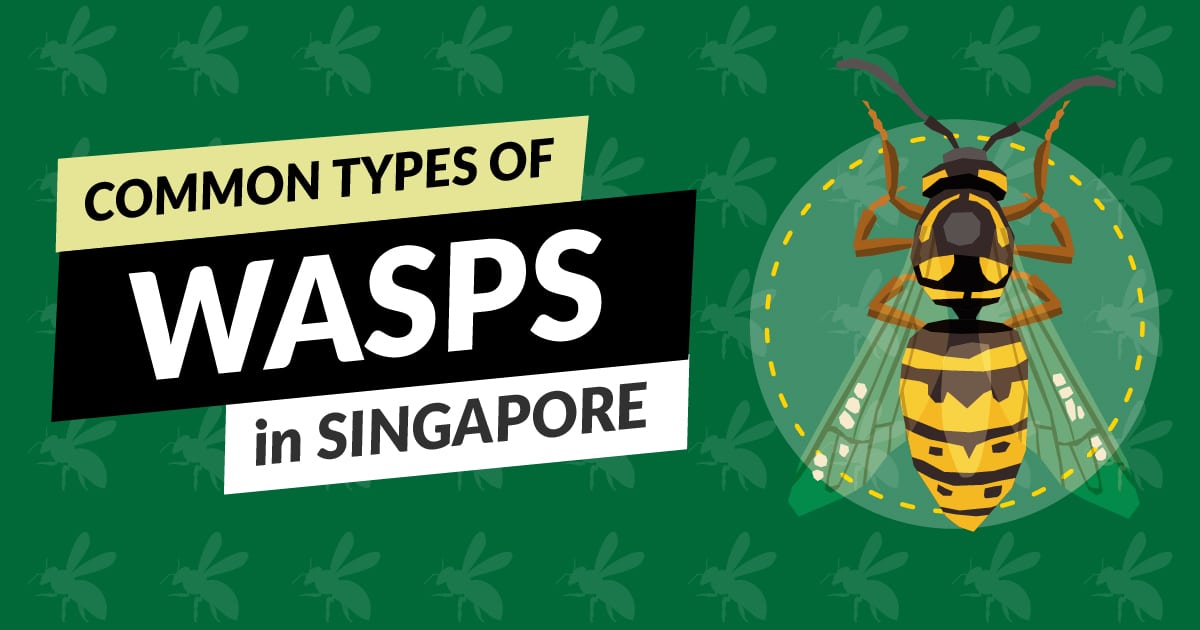
Types of Wasps in Singapore
Wasps can be distinguished between social wasps and solitary wasps. Social wasps share one nest, while solitary wasps nest alone. Hornets, yellow jackets, and paper wasps are examples of social wasps. On the other hand, thread-waisted wasps and mud daubers are characterized as solitary wasps.
Social wasps:
Paper wasps
Paper wasps are said to be the most common type of wasp in Singapore. Paper wasps have reddish-brown to black colour bodies with yellow rings around their abdomen. They are also called “umbrella wasps” because their nests resemble an upside-down umbrella supported by a single stalk.
Yellowjackets
Yellowjackets look quite similar to paper wasps. However, paper wasps have long and slender legs. The most common yellowjackets have bright yellow bodies with black lines, spots and triangles on their abdomen. Their body size is around 0.9 to 1.5cm.
Unlike paper wasps, yellowjackets use wood fibre to construct their nests. Yellowjackets may build nests in wall voids and attics, but they rarely cause structural damage to premises. Besides, they also build nests below the ground (not active rodent burrows), hollow logs, timbers or trees.
Hornets
People most often refer to yellowjackets as hornets. However, some hornets are much larger (can be up to 5cm) than yellowjackets. They can construct round or pear-shaped paper nests up to 90cm long. An entrance hole is always situated near the bottom of the nest. Hornet nests are most often built above ground, in high trees. However, they may attach their nests to the eaves of the buildings.
Solitary wasps:
Mud daubers
Mud daubers have longer and slender waists compared to most of the other wasps. Their body sizes range from 2 to 2.5cm. Nests of mud daubers are much smaller. They build mud tubes under buildings, roofs or attics.
Thread-waisted wasps
Thread-waisted wasps have incredibly narrow waists with a red or orange band between the waist and the abdomen. They also have long and skinny legs. The body size can be longer than 2.5cm, bigger than mud daubers. Thread-waisted wasps are ground nesters. They construct nests and seal them temporarily just before going out and searching for food.
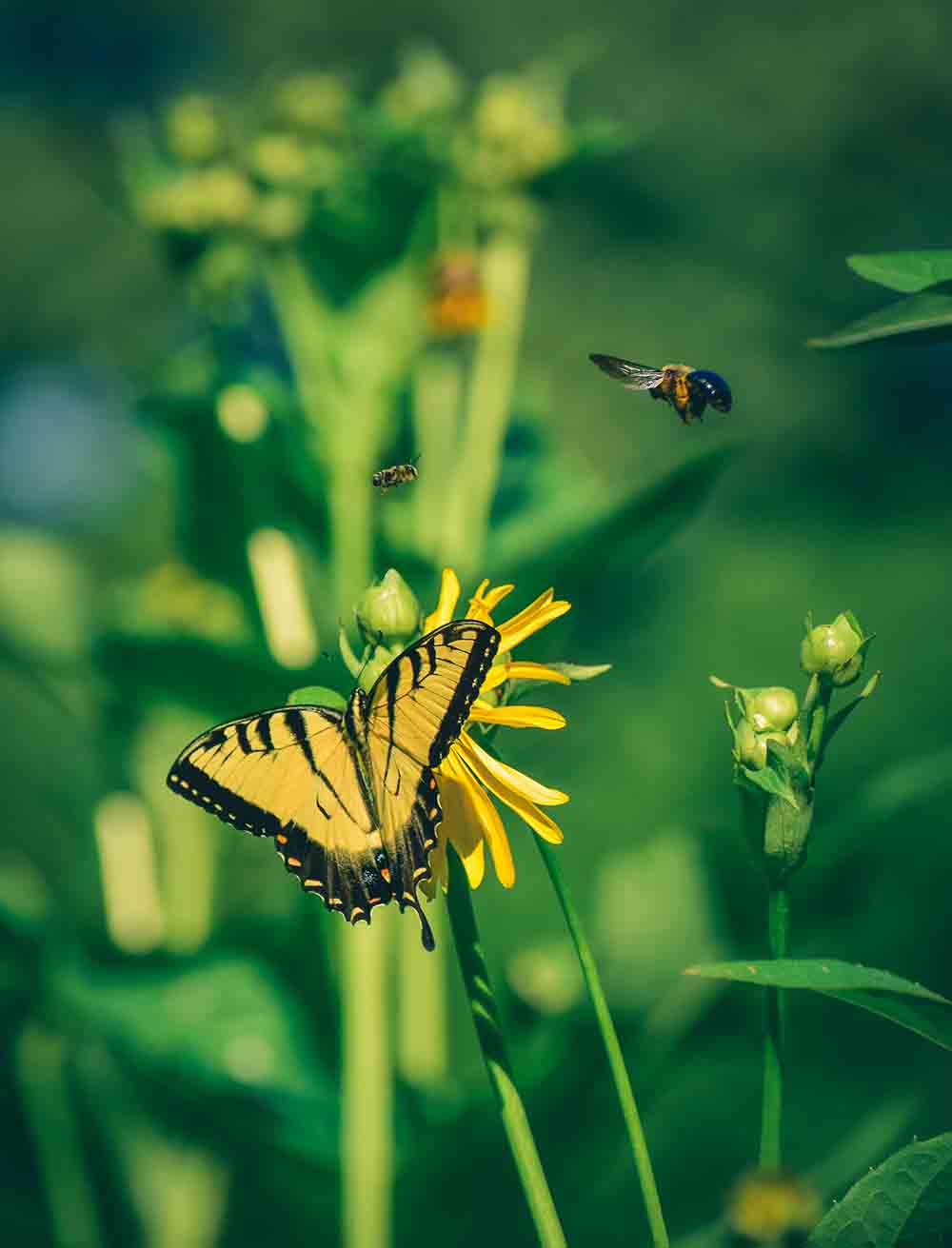
Life Cycle and Biology
A wasp nest is generally started from a solitary queen/female wasp. She will first build a small nest and raise the first generation on her own.
Social wasps
Social wasps have a caste system in their societies. One caste can have one or several queens. The workers are sterile females. A few drones (males) can also be found.
A mature paper wasp nest rarely has more than 200 cells and the nest usually contains 20-30 adults. Most social wasps have annual nests (survive a year). Social wasp workers typically have a lifespan of 12 to 22 days, while the queen usually can live up to a year.
Solitary wasps
Solitary wasps are also predators. Adult wasps feed on nectar and prey on insects or spiders to feed their young, just like social wasps. Different species of solitary wasps attack different types of insects. They sting, paralyze, drag or pick prey back to their nest. The larvae of the solitary wasp will then feed on the immobilized prey for their development and growth.
Hazards of Wasps
The ability of wasps to sting is the primary reason that people are worried. Wasps sting and inject venom from the rear part of their abdomen. Social wasps will vigorously attack humans when their nest is disturbed.
Nonetheless, they rarely sting away from their nest unless they are trapped or pressed against human skin. On the other hand, solitary wasps rarely sting unless threatened. The sting from solitary wasps usually causes a less severe reaction to humans than social wasps.
Wasp stings result in pain. Often, wasp stings are more painful than the sting of bees. The stings from wasps are usually not life-threatening but can last for a longer period. Allergic reactions may occur in some people. In severe cases, they may suffer an anaphylactic (hypersensitive) reaction if they are stung by the wasps. However, most deaths from wasp stings are because by allergic reactions to venom protein and enzymes from the wasps.
After being stung by a wasp, most people will only experience minor pain and swelling on the skin, while there are still many other symptoms that can be resulted from the sting of a wasp:
- Pain
- Redness
- Swelling
- Itching
- Flushing
Victims should seek medical care immediately if severe allergic reactions start to develop. Symptoms in more severe cases can be:
- Widespread rash
- Anaphylaxis
- Difficulty breathing
- Rapid pulse
- Low blood pressure
- Shock/respiratory distress
The best thing to do is to run to a protected area to prevent social wasps from stinging continuously and avoid danger.
Secondary effects from wasp stings
There is another problem resulting from getting stung by a wasp. Many people panic if there is a wasp around. Secondary hazards can occur if a person sees a wasp and suddenly starts running without noticing their surroundings. For example, this may happen while crossing a road.
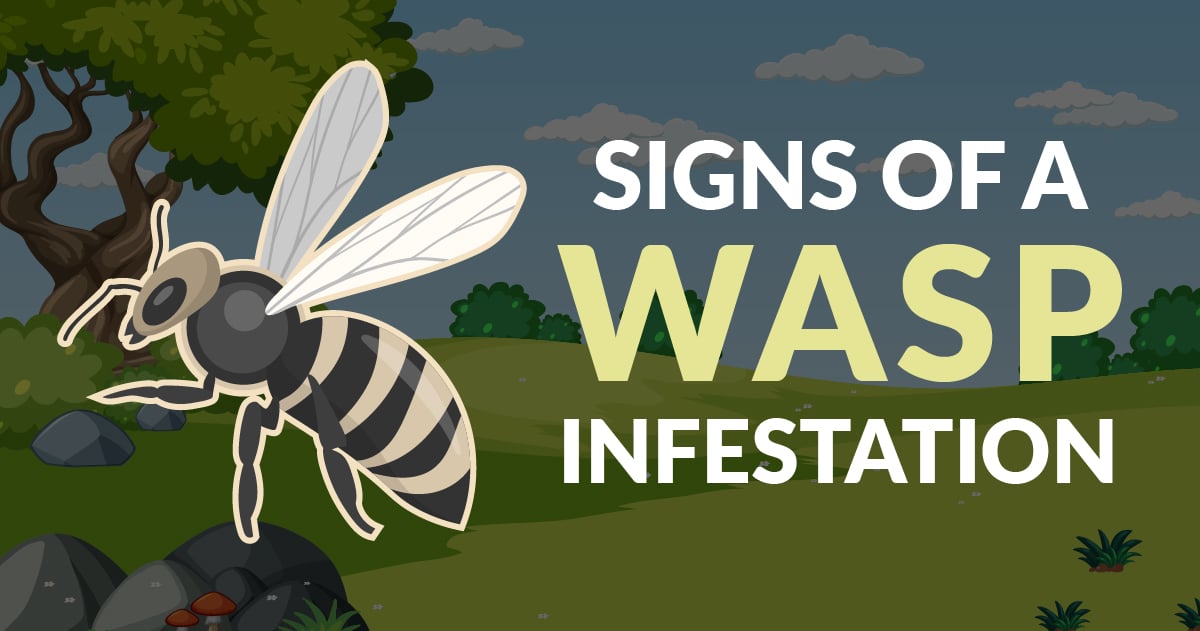
Signs of a Wasp Infestation
1. Sighting of wasps
This is quite an obvious sign that can tell you if a wasp nest is somewhere near you. You might need to follow and trace wasp nests if you wasps flying around your premises. What you can do is follow their flight path and check for the nest location.
2. Buzzing wasps
Buzzing happens especially when social wasps are around. This is because of their large number. The buzzing sound may give you a cue to locate their nest.
3. Sighting of wasp nests
You may do a thorough check around your house after noticing the first and second signs. Wasp nests can be found in trees, inside lofts, edges of roofs, in the corner of a quiet room, or even inside a wardrobe.

Tips to Prevent and Get Rid of Wasps
How to prevent wasps? It is almost impossible to eliminate wasps from us entirely as they are part of our ecosystem. Nonetheless, we can try to reduce their access to our living environment and make it less suitable for them to breed.
1. Eliminate new nests before they become a threat
It is usually safe to destroy a wasp nest when it is still in the earliest stage of development. However, if you are worried about the possible hazards, you may call a pest management professional to handle them.
2. Seal any openings that can be potential entry points for wasps
You can inspect and check around your house’s exterior. Use durable materials like caulk-based silicone, metal screen or similar sealant to repair or seal any openings, cracks or gaps that might harbour a wasp colony.
3. Reduce clutter
It is essential to reduce clutter in and outside of the house. Unused items such as lawn equipment, appliances or unwanted receptacles can attract and provide shelter for wasps to build their nest, especially when food and flowers are around.
4. Do not leave any food outside
After enjoying your dinner or barbecue in the backyard, always make sure to clean up immediately.
5. Make sure garbage bins are covered completely
Garbage bins can be one of the popular nesting sites for wasps because of the moisture and food. Make sure the bin lids are clamped down securely and inspect for any crack or hole on the surface of the bins.
6. Avoid overripe fruit in your garden area
If you are planting fruit trees in your garden, make sure to check to avoid overripe fruit frequently, as these attract wasps. You may also seal the fruit in a plastic bag or container to not attract wasps to come over.
Pro Tip: Because of the hazards and challenges, it's better to leave wasp management to pest control professionals.
DIY Methods to Get Rid of Wasps
There are a few DIY methods that might help to deter wasps from nesting around your house. These methods make use of the smell released from natural oil blends or plants.
1. Use of essential oils
Research has found that a combination of lemongrass, clove and geranium essential oils can successfully repel wasps. Mix several drops and apply the oils on potential nesting sites such as edges, roofs, cracks, and crevices. Furthermore, you may also target those areas that were previously occupied by a wasp nest.
2. Place/plant wasp-repelling plants around your house
You may plant some wasp-repelling plants around your house instead of those flowering plants that may attract wasps from coming in. Mint, eucalyptus, citronella, marigold, basil and geranium are some examples of plants that wasps find distasteful. You may also cultivate those plants indoors if you spotted wasps in the area before.
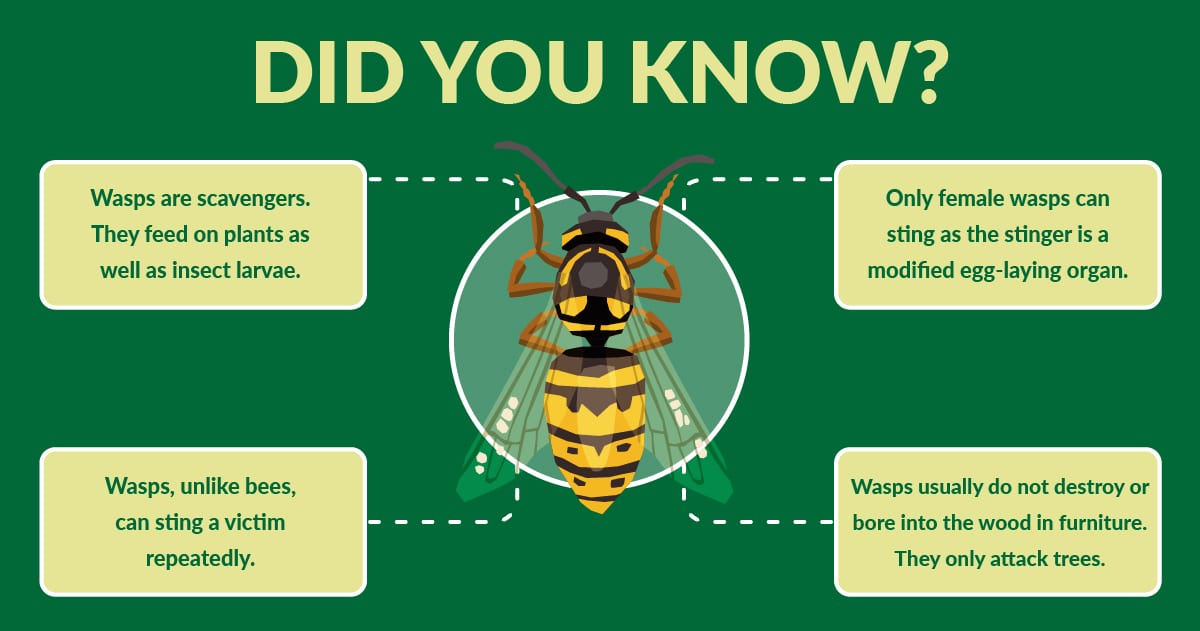
Professional Wasp Elimination Treatment in Singapore
Wasp management is best left for professionals because of its hazards and challenges in applying chemicals to the wasp nest. Pest management professionals are always equipped with the proper PPE (personal protective equipment) when dealing with bee or wasp nests. The PPE prevents them from getting stung.
Our trained pest management professionals use an effective chemical delivery system to reach wasp nests with an aerosol generator. The chemical or insecticide acts on the entire wasp colony and the nest is then removed from the infested area.
If you have wasp issues in your house or premises, please do not hesitate to contact Killem’s team. Our trained pest management professionals can help you get rid of your worries and make you feel safe again.
Frequently Asked Questions
It is not recommended to try to get rid of wasps by yourself. Wasp removal requires a lot of caution and is therefore best left to pest control professionals.
We can usually perform a wasp removal service within 2 working days.
In most cases, our pest professionals require up to an hour to perform the wasp treatment.
Related Posts
The Complete Guide to Rodent Prevention, Treatment and Control in Singapore
Pest Guides
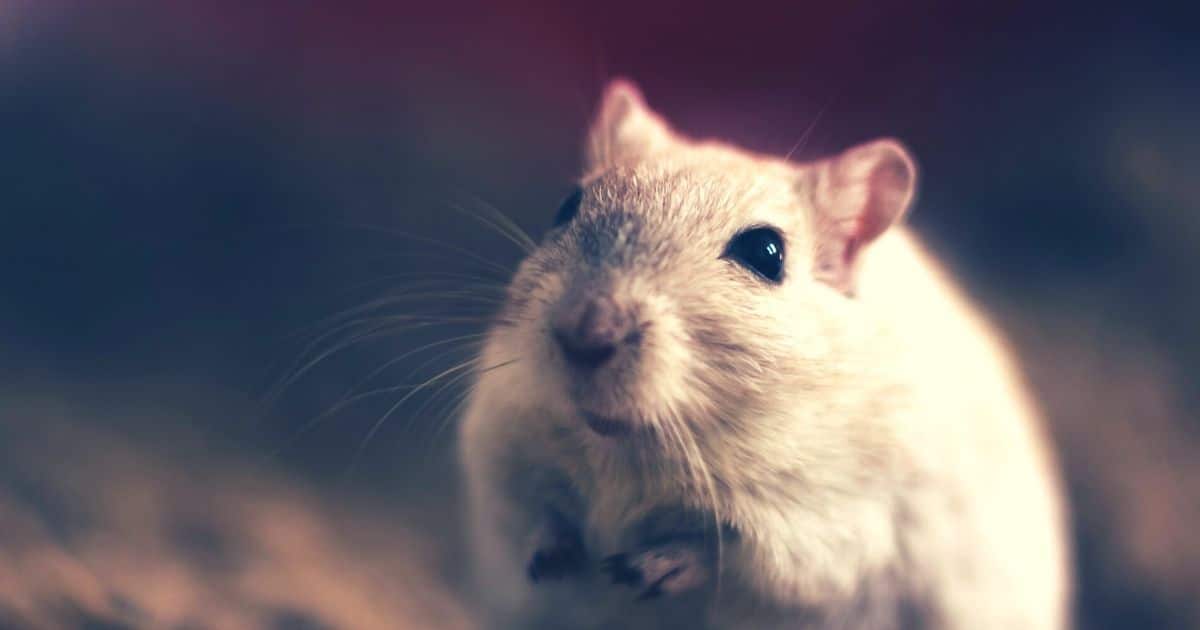
Rodents are mammals with a high degree of intelligence. Rodents belong to the family Rodentia which houses many other animals such as squirrels, hamsters, and guinea pigs. Among all rodents, rats and mice cause the most problem to our living environment. They can infest food, damage houses and buildings, and threaten public health. A rodent infestation is said to be a real headache in the pest management industry. The skills of rodents make the controlling efforts a challenging task.
What’s the Difference Between a Rat vs a Mouse?
Though rats and mice have similar food preferences and may look similar, they are not the same. One of the key differences between a rat and a mouse is their size: rats are usually larger than mice and can grow up to 26 cm in length, while mice are typically around 5 to 10 cm. Their tails also differ, as rats have thicker tails compared to the slenderer tails of mice. Furthermore, rats and mice have different behavior and habitat preferences, as rats are generally more cautious, while mice are known for their adaptability and making nests close to people.
To tackle rodent infestations, individuals use various methods like rat and mouse baits, traps, repellents, and poisons designed specifically for rats or mice. It is important to identify whether you have a rat or a mouse in your house to choose the right pest control methods.
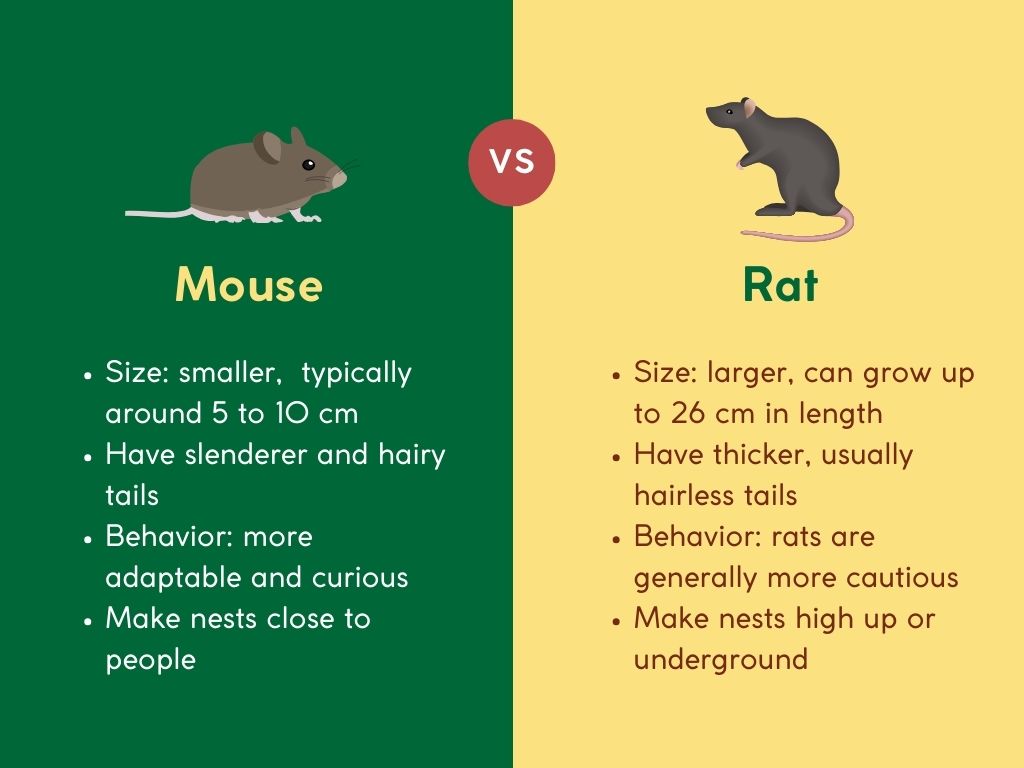
Types of Rodents in Singapore
There are 3 common rats and mice in Singapore, which are Norway rats (Rattus norvegicus), roof rats (Rattus rattus) and house mice (Mus musculus).
Norway rats are the biggest (body length range from 22 to 26 cm) among the three common species. They are also known as sewer rats, as we can always find them in the drainage system. Thus, that is one of their main travel pathways. Norway rats can be distinguished by their size, heads, ears, and tails. They have a robust body appearance, with a blunt muzzle and a shorter tail than the body.
Roof rats are famous for their climbing abilities. They are so-called agile climbers and are primarily found in elevated spaces. They have a smaller size (about 16 to 20 cm of body length), a head with a pointed nose, larger eyes, and ears similar to that of Norway rats.
The size of a house mouse is about 5 to 8 cm. Thus, they are smaller in size compared to rats. Like roof rats, mice also possess large ears and small black eyes.
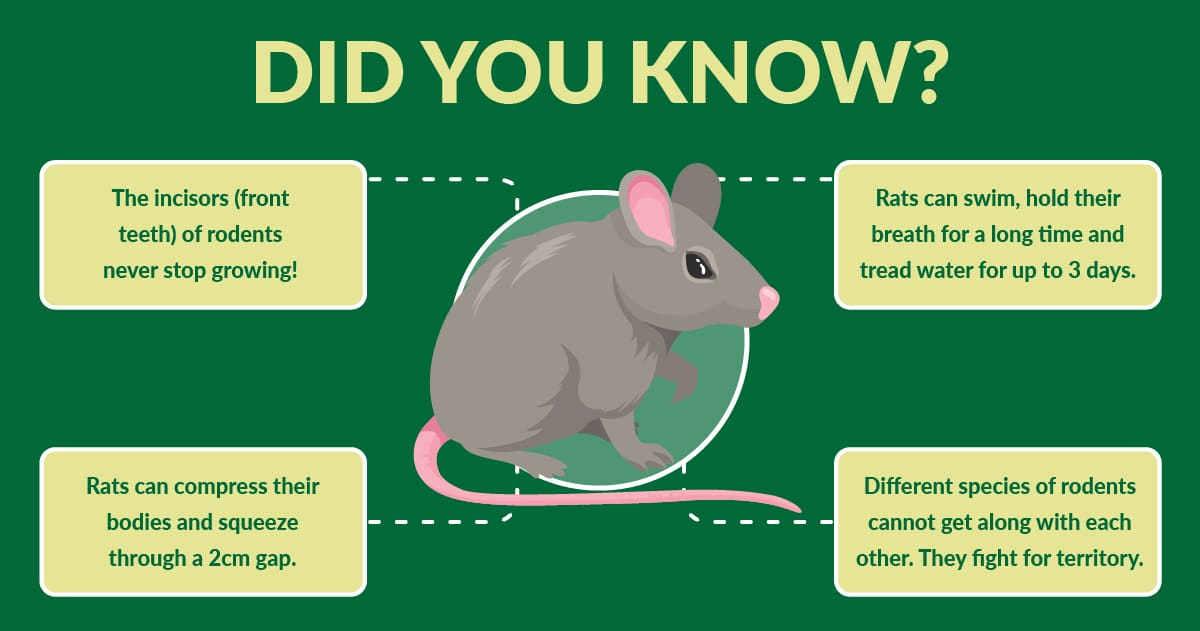
Life Cycle and Biology
Rodents are excellent in hearing, tasting, smelling and touching. However, they have poor eyesight. They are nocturnal animals, meaning that they are primarily active at night. As mentioned, rodents are smart. They explore and constantly learn, memorize food, water, pathways, nests, and the features of their environment. In addition, they have neophobia behaviour. Rodents usually avoid new objects such as traps and baits for a few days or more following their initial placement.
Norway rats are usually found at building foundations or lower levels of the buildings, especially in the basement. They are the main burrow builders and excellent swimmers. Norway rats can reach sexual maturity in about 2 to 3 months. They can reproduce and breed throughout the year in favourable conditions. One female can give birth to about 5 to 14 litters per year.
Roof rats are agile climbers who usually nest at a higher elevation, such as false ceilings, attics, cabinets, trees and dense vegetation. When roof rats invade buildings, nesting materials such as shredded paper, newspapers, and dried plant materials are used. You can always see them running along utility pipelines and overhead fence tops. One female roof rat can produce 3 to 5 litters per year.
House mice are also excellent climbers. They can even squeeze through holes of less than 1 cm in diameter because of their tiny size. House mice can have 5 to 10 litters in a single year. They can also easily enter buildings. As a result, house mice infestations are more common and severe than rat infestations.
Interesting fact: House mice infestations are more common and severe than rat infestations.
Medical Importance
Rats and mice are capable of causing structural damage and transmitting diseases (to human beings) such as:
- Rat-bite fever
- Salmonellosis (food poisoning)
- Leptospirosis
Diseases are transmitted through bite wounds, food, waste products, or indirectly by fleas, ticks and mites via close contact.
Here are some of the symptoms of rodent-borne diseases:
- Fever
- Chills
- Muscle aches
- Headaches
- Cough
- Nausea
- Vomiting
- Loss of appetite
In severe cases, some symptoms may show, such as:
- Weight loss
- Fatigue
- Swollen ankles, feet, or hands
- Decreased urination
- Shortness of breath
- Rapid heartbeat
- Jaundice
- Confused mental state
- Aggressive behaviour
- Seizures
- Inability to control your movements
- Inability to speak
- Aversion to lights
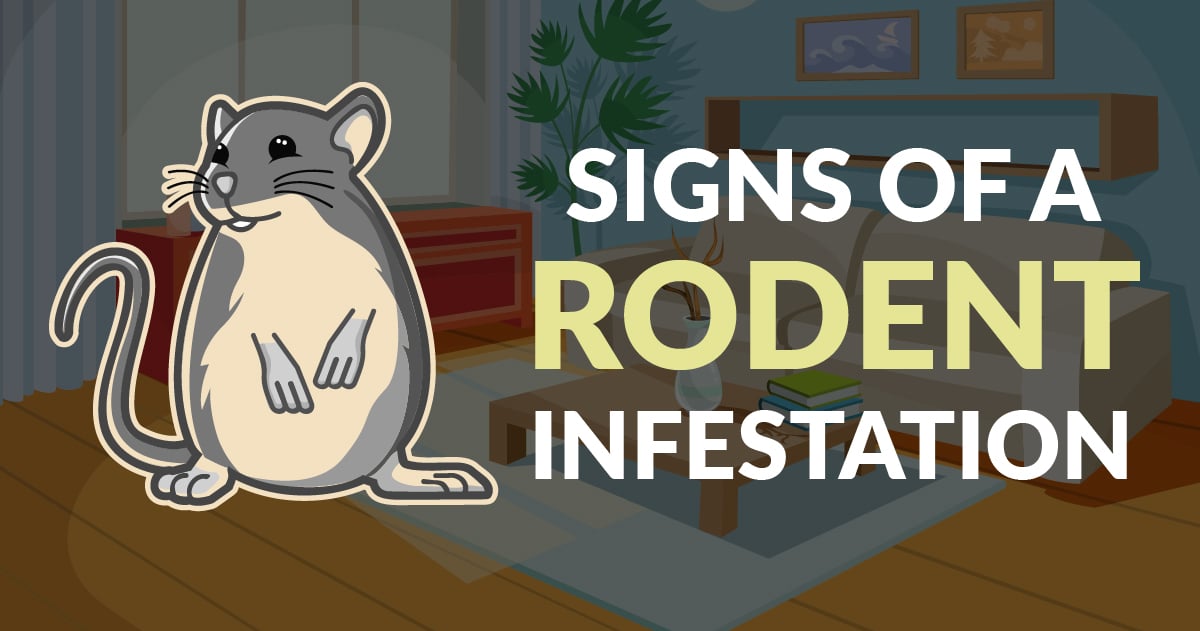
Signs of a Rodent Infestation
Rodents are nocturnal animals. We often do not notice their presence until the infestation becomes severe. Here, we will share the tell-tale signs of a rodent infestation.
1. Gnaw marks
As mentioned, the incisors of rodents never stop growing. This is one of their survival behaviours! They gnaw their incisors to gain food, and resources, invade buildings, build nests, assist in climbing and use them as weapons to fight the enemy. Rodents are seemingly attracted most to electrical wires and wooden structures.
2. Bite signs on food packaging
Rodents can bite through many food packages such as plastics, paper sacks and cardboard. Their teeth are strong and sharp enough to bite through those materials to obtain food.
3. Rodent droppings
Rodents can produce 20 and 30 droppings in a single day. In short, droppings are a good indicator to inspect for rodent activities. Furthermore, the shape and size of droppings can help in checking for rodent species.
4. Rub marks
Rub marks refer to the dark grease left by rodents when they follow a trail or pathway between their nest and available food source. The dark grease or dirt marks are caused by the oily fur of rodents.
5. Urine stain and odour
In heavily infested rodent areas, we can sense stale smells coming from hidden places. Rodents use scent to mark their territory, and convey information and social dominance.
6. Burrows
Norway rats’ burrows are always found along with building foundations, especially in the external garden area. When they invade the building, they usually nest at lower elevations.
7. Live/dead rodents
Seeing a live or dead rat or mouse on your premises is a potential sign that you have a rodent infestation. Also, if you find rodents during the daytime, this may indicate that you have a heavy infestation on your premises.
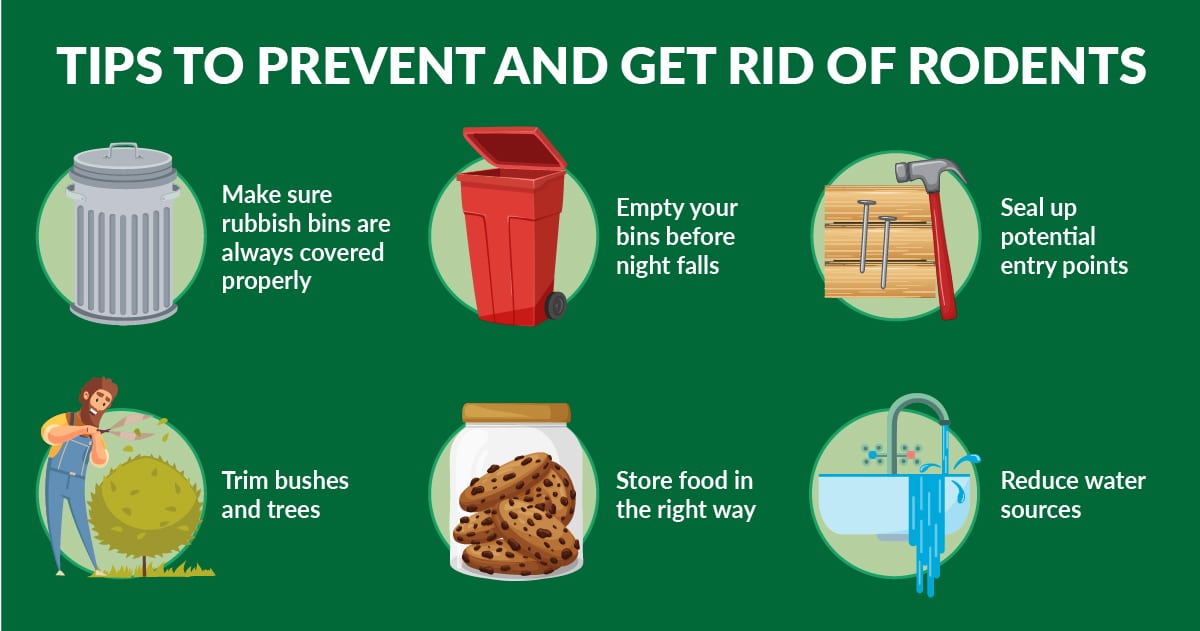
How to Prevent Rodents from Invading Your Home
You may have probably been disturbed and heard rodents squeaking at night or see them running in the kitchen area or backyard. This is because they always live near humans, searching for food that people leave behind.
As mentioned, rodents are excellent swimmers or agile climbers. For them, it is not a difficult task to find a way to invade our premises. Hence, how do we prevent them from coming in?
1. Make sure rubbish bins are always covered properly
Rodents, especially house mice, can squeeze through tiny spaces. It is advisable to always keep rubbish bins closed. As such, they are denied access and cannot gain food from bins.
2. Empty your bins before night falls
The smell of food waste in kitchen bins can attract rodents and other pests to thrive. Rodents are nocturnal pests. So, make sure food waste is always disposed of daily before night.
3. Seal up potential entry points
Both rats and house mice are capable of climbing. Therefore, make sure to inspect buildings, especially rooflines. Also, be aware of the potential rodent entry points and take necessary sealing and repairing works on the entry points found.
4. Trim bushes and trees
Rodents use thick foliage to protect and cover themselves from predators. Roof rats and house mice can climb up to buildings or premises from shrubs and trees near the exterior foundation. Hence, always make sure to trim bushes and trees around your premises to prevent giving them a favourable environment to thrive.
5. Store food in the right way
As rodents can bite through food packages, storing food in tightly sealed containers or placing food in the refrigerator is essential. The same goes for pet food, which should not be left out all day long or overnight as it will attract rodents and other pests.
6. Reduce water sources
Leaking pipes need to be fixed to reduce available water sources for rodents and other pests. The drainage system also needs to be improved if standing water is sighted and the drains are blocked. Besides, floor traps need to be covered at all times to prevent rodents from coming in through the drainage system.
7 Tips for Keeping Our Bins and Bin Chutes Free of Rodents
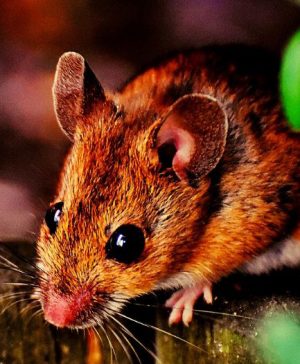
DIY Methods to Get Rid of Rodents
Set your own rat/mousetrap:
- Buy traps in the market (it is recommended to buy traps that can prevent them from suffering).
- Make your own traps by referring to online tutorials (avoid catching the live one as you may need to kill or starve them afterwards).
- Choose peanut butter as the bait rather than cheese (they prefer high protein and oil-based food).
- Place traps perpendicular to walls (as that is their pathway).
- Wear removable gloves.
- Dispose of them by using tightly sealed black plastic bags.
Professional Rodent Treatment
In the case of a severe rodent infestation, treatment methods can become complicated. It is usually the combination of at least 2 to 3 methods to identify and solve a heavy rodent infestation. Help from a professional pest control company is strongly advised.
Exclusion
Identifying rodent entry points can be challenging to untrained eyes as mice can squeeze through dime-sized holes. These tiny holes can be easy to miss out on. Our pest management technicians are trained to inspect and identify the potential holes rodents or mice might use to gain food in your premises.
Rodenticides
When the rodent infestation is severe, we might need to place rodent baits outside the premise to achieve adequate control. Rodenticides are placed in a tamper-proof rodent bait station to avoid non-target animals from feeding.
Trapping
Pre-baiting
As rodents have a neophobia (bait shy) effect, pre-baiting is usually the initial stage to ensure they feed on the baits placed in the traps. The baits that we use are non-toxic and formulated with more than 15 human foods to gain attraction.
Trap with baits
After pre-baiting (usually about a few days or weeks), traps with the same baits will be activated. This stage usually proceeds until no more rodents are trapped and signs of infestation are not sighted anymore.
Our trap can send an alert to us once the rodent is caught. Then, immediate removal of the carcass can be done.
Rodents live in close association with humans and feed on whatever humans eat. Hence, you might have been providing them food without even knowing it! Therefore, maintaining the best housekeeping practice is the most reliable method to keep your premises clear from pest invasions.
However, controlling and catching rodents on your own is not a good idea when it comes to heavily infested areas. Instead, seek help from professionals now!
Frequently Asked Questions
Contact us now. Our team of experts are ready to eliminate your rat or mice problem.
Food is one of the primary reasons why rodents enter your home or office. Make sure to seal food properly and to clean areas where food is processed and eaten.
In some cases, traps for mice and rats are useful, but only if your home or office is not yet infested heavily.
Related Posts
The Complete Guide to the Prevention, Treatment and Control of Midges in Singapore
Pest Guides
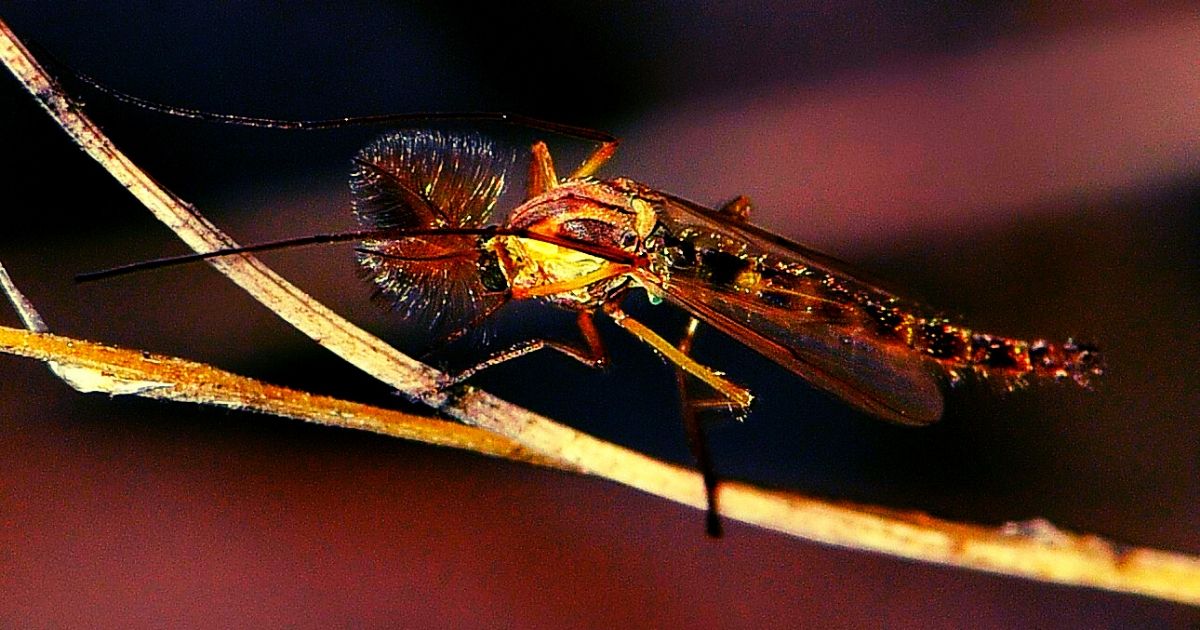
Midges are common insects in urban environments. In Singapore, it is not unusual to see swarms of midges near reservoirs. These areas provide favorable conditions such as ample food in the water and optimal temperature during certain times of the year. Midges are often mistaken to be mosquitoes because of their similar appearance. However, you can actually recognize midges if you look closely. Their bodies are slender and longer compared to mosquitoes. Most of the midges found in Singapore have distinct green bodies.
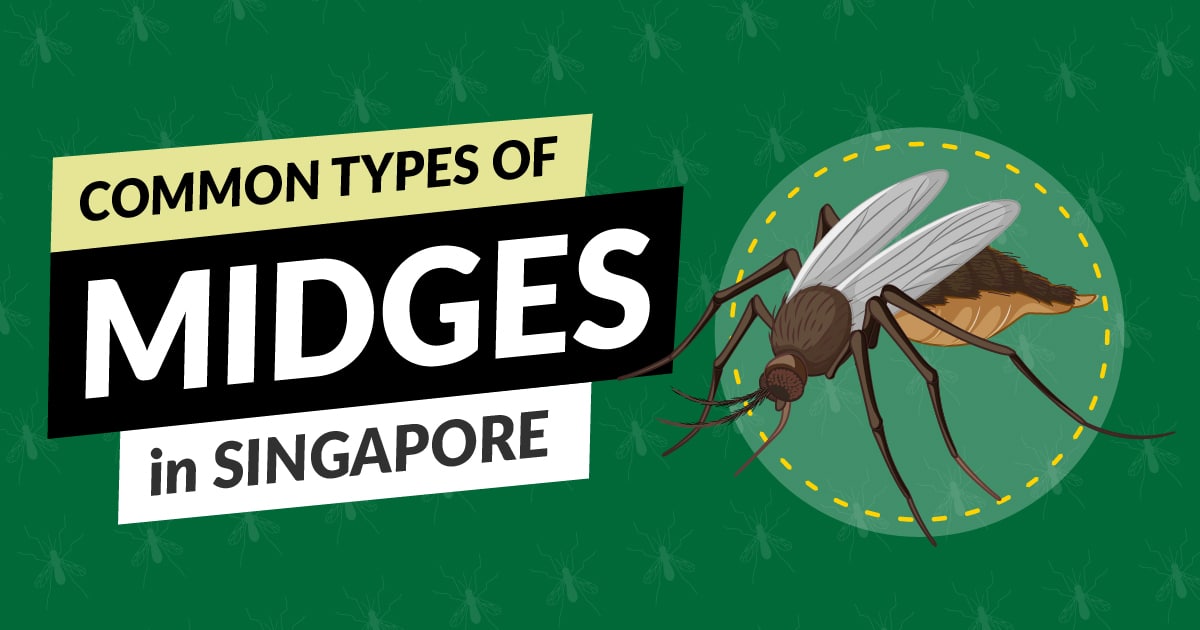
Types of Midges
Midges can be categorized into two main groups, namely:
Biting midges found in Singapore are in the family of Ceratopogonidae, while non-biting midges are in the family of Chironomidae. In Singapore, biting midges are also known as sand flies, but some may call them “No-See-Ums”. As the name implies, biting midges are bloodsuckers, leaving painful bites on human and animal skins. On the other hand, non-biting midges do not bite and feed like biting midges. Non-biting midges do not cause and transmit diseases to humans as mosquitoes do. However, they are defined as nuisance pests to humans.
Life Cycle and Biology
The life cycle of midges is similar to that of mosquitoes. The life cycle of both biting and non-biting midges involves four development stages, namely:
- Egg
- Larval
- Pupal
- Adult
Biting midges
The complete life cycle of biting midges takes about 2 to 6 weeks, depending on the species and environmental factors. Both male and female biting midges feed on nectar. However, females require human or animal blood for their eggs to mature. Females usually fly into the male swarms for mating. This occurs when females finish feeding on blood.
Larvae development requires a moisture source. They need water, air and food for survival. Larvae develop in ponds, streams or muddy substrates, and they feed on organisms around them. The pupae stage can last from 2 to 3 days. The lifespan for an adult biting midge is usually up to a few weeks.
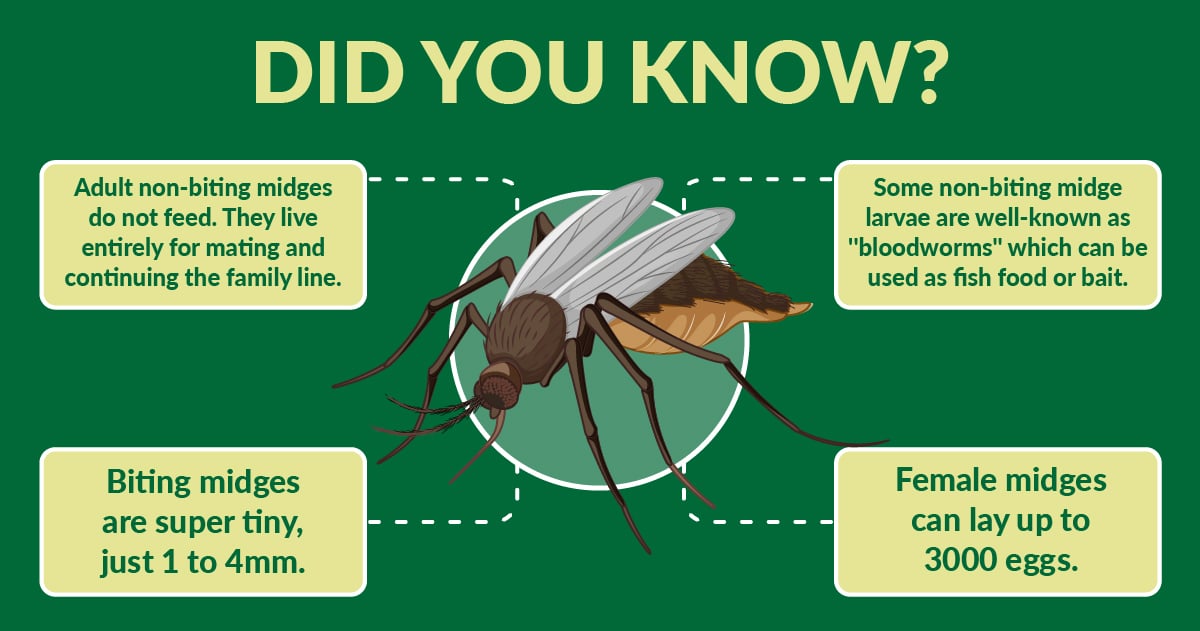
Non-Biting Midges
Non-Biting midges do not possess proboscis. The proboscis is a needle-like mouthpart found on insects such as mosquitoes and biting midges. It is an important feature used to suck blood.
The breeding habitats of non-biting midges are similar to mosquitoes, namely in stagnant water and slow-flowing water. Common places where you can find them are drains, water reservoirs, water tanks, ponds and lakes.
The complete life cycle takes about three weeks to complete. Non-biting midges have a better reproductive capability than biting midges. Females can lay eggs in masses that contain up to 3000 eggs. The larvae feed on sediments or organic matters in the water.
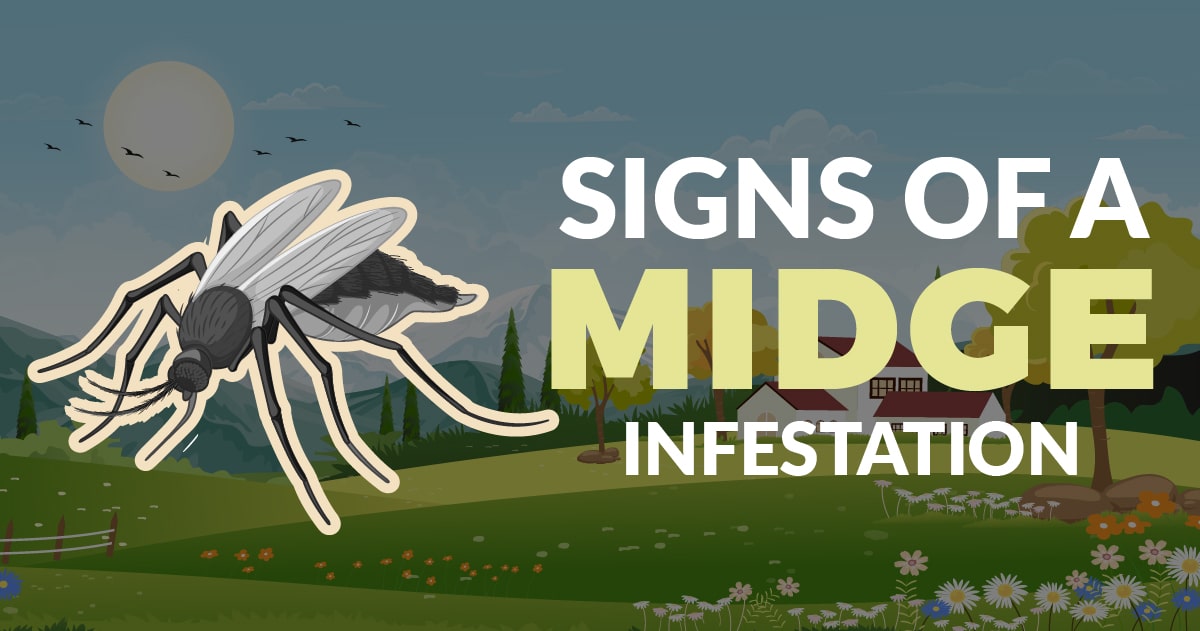
Signs of Midge Infestations
The swarming of midges is the most obvious sign of a midge infestation. You can notice the swarms, especially during dawn and dusk. Non-biting midges are harmless but are a nuisance to people. However, biting midges or sand flies can deliver painful bites, leaving red bumps that cause an itch.
Interesting fact: Some adult midges look similar to mosquitoes, but unlike mosquitoes, they do not eat or drink, and their bodies are usually longer and more slender.
Medical Importance of Biting Midges
Biting midges can cause a disease called leishmaniasis. Not to worry, there is no endemic transmission record of this disease in Singapore. Besides, the species that cause this disease are Phlebotomus and Lutzomyia spp., which do not appear active in Singapore.
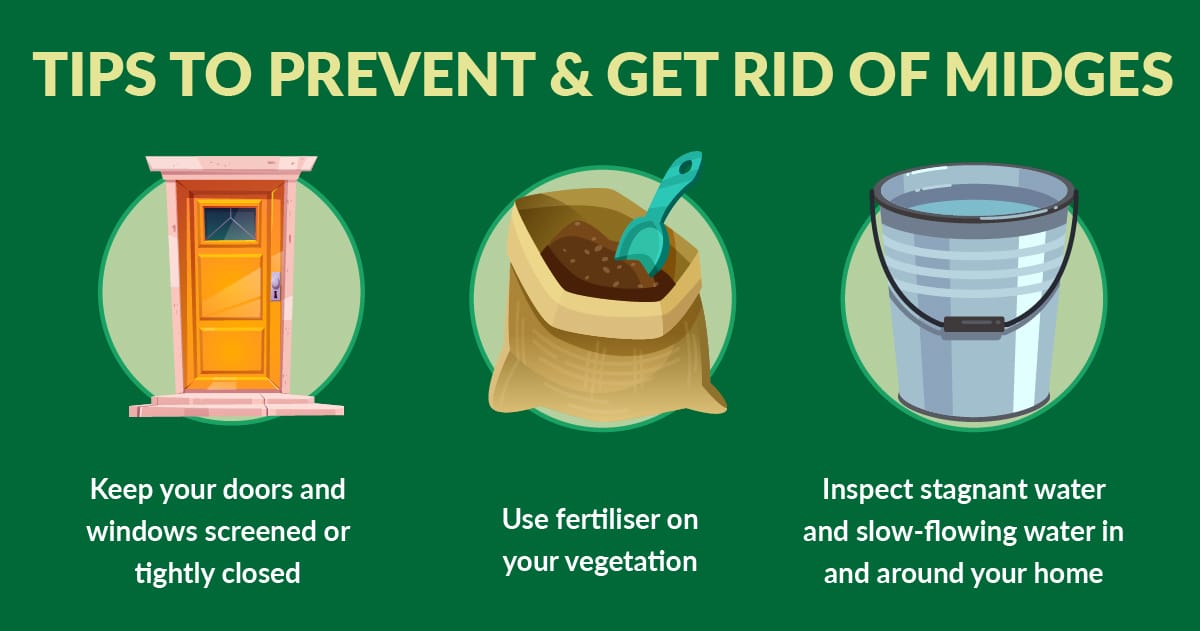
How to Prevent Midges In and Around your Home
1. Keep your doors and windows screened or tightly closed
To screen your windows, the wire mesh size must be small enough to exclude all species. Ensure always to remind yourself to close doors and windows, especially during dusk and dawn, as these are midges’ most active hours. Prevention during this time prevents Aedes mosquitoes as well. If you are not planning to screen your windows, you may install curtains to lower the chances of denying their access.
2. Always inspect stagnant water and slow-flowing water in and around your home
As previously mentioned, the developmental stages of the midges are similar to mosquitoes. They need to go through larval and pupal stages before emerging as adults. Midge larvae are most likely to be found in reservoirs, lakes and ponds. Other than that, they can be found in stagnant and slow-moving water.
The greenery and plants around the home are the most susceptible areas to become their breeding habitats. Stagnant water found on soil, in planter plates, or in boxes can become potential breeding places. Besides, the soil nutrients further contribute to the growth of their larvae, giving them access to ample food and enough water to survive through their developmental stages
3. Use fertiliser
Midge larvae prefer to develop in nutrient-rich habitats. Always remember to fertilise your plants properly by checking and following the guidelines of the fertiliser used. This is to prevent excessive use of fertiliser, resulting in fertiliser runoff in the soil to the surrounding ponds, drains, and streams. The excessive use of fertiliser can promote their growth of development as nutrients are drained from the soil to their breeding habitats.
Tips to Prevent and Get Rid of Midges (DIY Methods)
1. Use insect repellents
Insect repellents aim to repel midges away from you without killing them. Some people may have sensitive or allergy skin towards chemical-laden repellents. To protect sensitive skin from chemicals, you may apply natural insect repellents that contain substances such as citronella and tea tree oil from the market.
Although non-biting midges do not bite and transmit diseases, they can be a nuisance. Application of insect repellents is the easiest and most environmentally friendly method to protect you from midges‘ disturbance.
2. Use dim or yellow lights
Midges are highly attracted to bright light. Hence, yellow or dim light bulbs are advised, especially at doors and windows. In addition, you can always switch off the lights that are not in use in the exterior part of your home. This method is not aimed at eliminating midges but can help to reduce the presence around your living environment.
3. Make the environment less conducive (eliminate their habitats)
The reasons for midges to breed around your home are always the presence of stagnant and slow-moving water bodies. This includes over-watering of plants, hardened soil and insufficient drain gradient. Overwatering of plants and hardened soil in the planter boxes often cause the formation of stagnant water on the soil.
Always make sure to loosen the soil regularly and avoid over-watering plants to prevent the formation of ponding water. On the other hand, you may need to remove blockages such as stones, dry leaves, debris and algae formed in the drains regularly to improve the flow of drain water. You may also re-grade your drain if a poor gradient was found as midge larvae can withstand the weak water current in the drain.
4. Use Bti or mosquito dunk
Bti (Bacillus thuringiensis israelensis) or mosquito dunks can easily be bought in stores. These can be placed safely in and around your home if the formation of stagnant water bodies is difficult or troublesome to be cleared.
Bti is a bacterium that can infect the guts of mosquitoes and midge larvae. It is environmentally friendly as it does not affect or kill beneficial insects, aquatic animals and plants. Bti can be introduced into ponds, poorly maintained water fountains and gutters.
7 Tips on How to Get Rid of Midges

Professional Midge Treatment
It is quite a simple task to deal with a small number of midges present at your premises. However, it can become challenging to control midges when their numbers increase and start affecting your daily life.
The treatment methods used in Singapore for midges can be divided into the following methods:
- Physical
- Biological
- Insecticidal
The most basic physical method is the removal of their breeding sources. Inspection plays a vital part in this. Remove midges‘ breeding source via S&D (search and destroy). However, some other methods have been used in Singapore. For example, a 3 metres high netting was introduced at the reservoirs to prevent midges from flying or being blown to the residential areas. Besides, spotlights were deployed remained switched on from 7 am to 7 pm to attract and keep midges within the reservoirs.
The application of Bti (Bacillus thuringiensis israelensis) is one of the biological methods that the government and pest control industries use. This is because it is safe (no risk to humans, animals and aquatic life), target specific and does not affect the water quality. Another biological method that the government uses is the release of predators to hunt for midge pupae (the prey), reducing the population of adult midges. In Singapore, thousands of predatory fish (guppies, mollies and swordtails) were released into the reservoirs as they are the predators of midge pupae.
Furthermore, insecticidal approaches are commonly used in pest control industries in Singapore, namely:
- Thermal fogging
- Misting
- Larviciding
Thermal fogging and misting are two treatment methods to target adult flying insects, especially mosquitoes and midges. Thermal fogging targets flying insects present during the treatment period. Misting creates a residual effect on the treated surface and kills them upon contact. In short, thermal fogging acts as a “quick fix” solution to provide fast control to reduce the population of targeted insects while misting protects over a more extended period.
On the other hand, larviciding is the application of larvicide into stagnant water. It is used to target larvae before they can grow to adults. Licensed and certified companies in Singapore strictly carry out all the methods discussed here.
At Killem Pest, we provide a physical approach by carrying out S&D (search and destroy). Inspection is not an easy challenge. Our pest control professionals are trained to have the required knowledge and ability to search for midges breeding places.
Besides, environmental health is always our concern. Hence, we also offer a biological approach by providing or applying Bti upon request or in sensitive areas. In addition, all the chemicals used in insecticidal methods are approved by NEA (National Environment Agency). The chemicals do not pose harmful effects to humans and animals.
Frequently Asked Questions
Midges don’t transmit any human diseases, however, it’s known that their bites can be painful and can cause a severe allergic reaction.
Midges can cause discomfort for people, but they are not considered dangerous. On the other hand, midges can spread diseases to animals, like livestock, and can be considered deadly.
The best way to protect yourself from biting is to cover up your skin. Choosing light-coloured clothing can also help, as midges are attracted to dark colors.
Related Posts
Nothing found.
The Complete Guide to Snake Prevention, Treatment and Control in Singapore
Pest Guides

Snakes are one of the most common reptiles that we may encounter in our daily lives. Despite having no limbs, snakes can slither with smooth and agile movements. In Singapore, encounters with snakes are not rare. There are frequent news reports on snake presence in Singapore.
Snakes are kept as pets by people in other parts of the world, but it is illegal to keep snakes in Singapore. Although snake enthusiasts may find their pets alluring, snakes can be fearsome to some people, especially those who have had bad experiences with snakes. One of the reasons that cause people to be afraid of snakes is their ability to deliver fatal bites. However, not all snake bites are dangerous. There are plenty of non-venomous snake species.

Types of Snakes in Singapore
There are over 3000 snake species in the world, but not all of them can be found in Singapore. Here are some common types of snakes in Singapore:
- Reticulated Python (Malayopython reticulatus)
- King Cobra (Ophiophagus hannah)
- Black Spitting Cobra (Naja sumatrana)
- Oriental Whip Snake (Ahaetulla prasina)
- Banded Krait (Bungarus fasciatus)
- Banded Malayan Coral Snake (Calliophis intestinalis)
Reticulated Python (Malayopython reticulatus)
The reticulated python is the longest snake in the world. It can reach over 8 meters. Reticulated pythons have a distinct, alternating, consistent zigzag pattern of black, yellow, brown, and white scales. It is non-venomous and feeds mainly on small mammals, rodents, and birds.
Although the reticulated python is non-venomous, it has the strength and length to constrict its prey before feeding on it. It is nocturnal, meaning that the reticulated python is primarily active at night. In addition, it can be found in a wide range of habitats from low land to highland, forests, mangroves, and drain canals. In Singapore, pythons are commonly found inhabiting urban areas such as drains and canals.
King Cobra (Ophiophagus hannah)
The king cobra is notoriously known as the world’s largest venomous snake with an average of 3 meters in length. King cobras can be found in varying colours but are mainly in shades of light brown to dark brown and even black with a pale-yellow tint.
King Cobras are diurnal as they usually hunt during the day. Their diet consists of other snakes, rodents, and lizards. King Cobras are shy and retreating. However, they can be aggressive when provoked or cornered. Thus, one should never try to confront King Cobras to avoid getting fatal bites.
Black Spitting Cobra (Naja sumatrana)
The Black Spitting Cobra is also known as the Equatorial Spitting Cobra. As the name suggests, the black spitting cobra can contract its venom gland to spit venom onto its target, mainly aiming for the eyes. The venom can cause severe damage to the eyes and their surrounding areas, and may cause blindness if left untreated. The Black Spitting Cobra diet consists of rodents and amphibians. It is active at night, and prefers cooler places like shelters, drains, and garden walls.
The 6 Common Snakes in Singapore
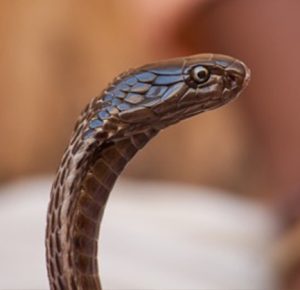
Oriental Whip Snake (Ahaetulla prasina)
The oriental whip snake is a fairly small and lanky snake. Its appearance can range from light brown to bright green, and its coloration allows it to blend in with vegetation. Oriental whip snakes can grow up to approximately 2 meters in length. They feed on birds, lizards, and frogs with the help of their venom. As the venom is usually relatively weak, oriental whip snakes are not problematic to humans. Oriental whip snakes are active during the day and are typically seen amongst low-hanging trees or tangled between vines in forested areas.
Banded Krait (Bungarus fasciatus)
The banded krait is one of the more prominently patterned snakes with black and white stripes from head to tail. It feeds mainly on other snakes as well as animals such as rodents, lizards, cats, and fish. Banded krait is nocturnal and can be found in forested areas near rodent holes, termite mounds, and places close to water. This species should always only be spotted from afar and not approached, as it is venomous and may bite if threatened.
Banded Malayan Coral Snake (Calliophis intestinalis)
The banded Malayan coral snake has an average size of 40 to 60cm in length. It can be distinguished by its bright red tail and reddish stripe along the length on the top side of the body. Banded Malayan coral snakes feed on other snakes and are active at night, commonly found in forests, parks, and gardens. Although a banded Malayan coral snake may look small and attractive, its venom is potent, so one should never try to approach it.
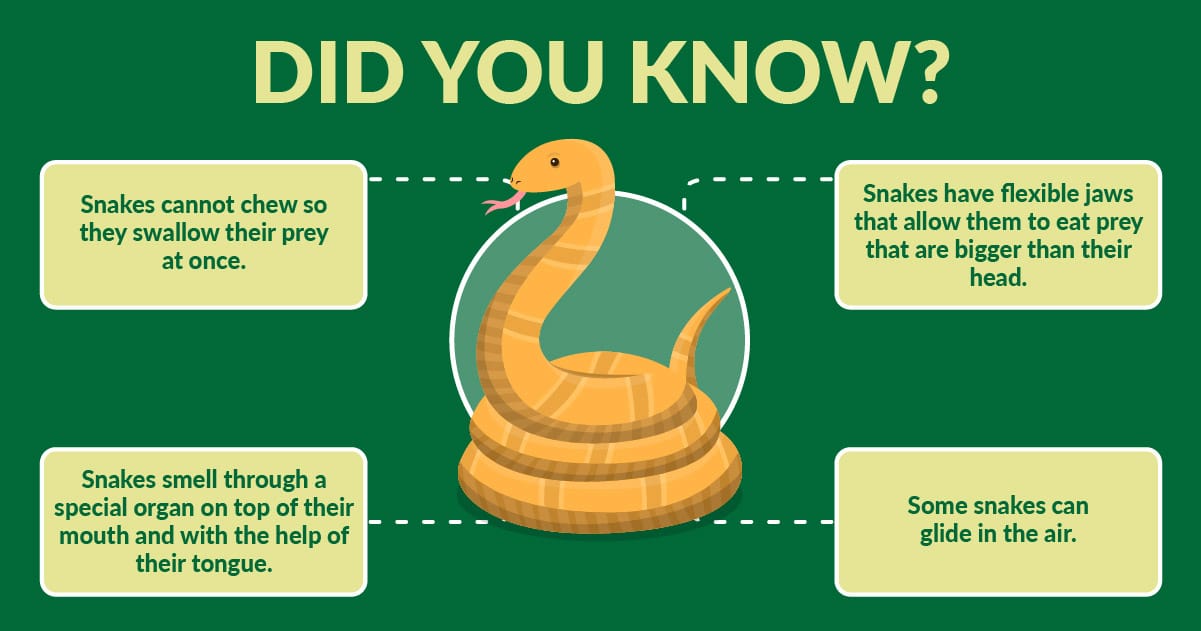
Life Cycle and Biology
Depending on the species, snakes can live more than 20 years, with the larger ones having a longer lifespan than the smaller ones. Snakes are born in eggs. There are two types of egg births known:
- Oviparity
- Ovoviviparity
Most snakes are oviparous, meaning that they lay their eggs outside their bodies, and young snakes will hatch from the eggs. Ovoviviparous snakes also produce eggs, but they keep the eggs inside their bodies during incubation. The newly hatched snakes will look like they were born directly from the mothers’ body.
Although snakes are legless reptiles, not all legless reptiles are snakes. For example, lizards only have front or back limbs or are completely legless. All snakes are predators, but only a portion of them are venomous. Even a smaller fraction of snakes are capable of inflicting lethal bites.
Interesting fact: Snakes can't chew their food, so they have to swallow it whole (even items up to 10 times bigger than the size of their head).
Medical Importance
One reason that causes the fear of snakes is a snakes’ ability to inflict lethal bites. According to the World Health Organisation (WHO):
- There are over 3000 species of snakes in the world
- 600 snake species are venomous
- Over 200 species of venomous snakes are considered to be medically important
These medically important venomous snakes can cause injury, disability, and even death. The symptoms associated with snake bites vary depending on the type of snake.
Symptoms include:
- Puncture wounds or bite marks on the skin
- Redness, swelling, bruising, blistering, or bleeding around the bite
- Severe pain and tenderness
- Nausea, vomiting, diarrhoea, dizziness, headaches, and blurred vision
- Shortness of breath
- Rapid heart rate, weak pulse, low blood pressure
- Metallic, mint, or rubber taste in the mouth
- Increased salivation and sweating
- Numbness or tingling around the face and/or limbs
- Muscle twitching
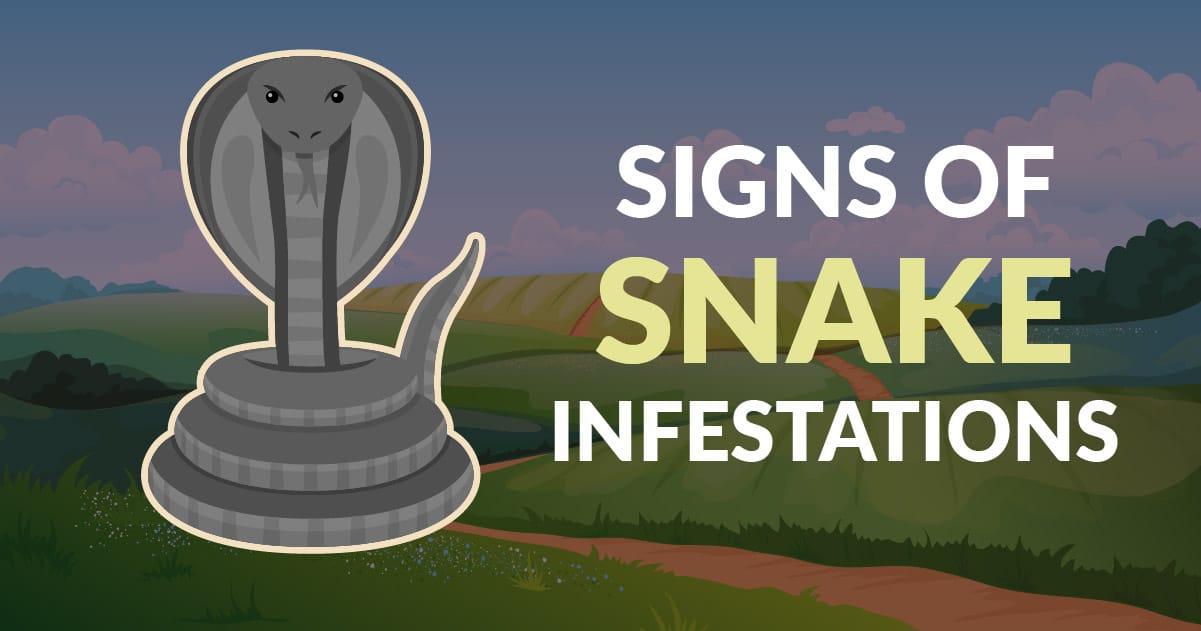
Signs of Snake Infestations
1. Shed skin
Snakes shed their skin as they grow. The discarded skins may be found in places where snakes rest. This is one of the most apparent signs of snake infestations. While it may be fine to spot one around your house, you should be concerned if you see snakes frequently.
2. Slither tracks
Snakes have a unique movement known as slithering. As they slither, they leave behind distinct tracks on the dusty or sandy ground.
3. Droppings
The faeces of snakes are another important sign of a snake infestation. Snakes’ faeces may resemble birds’ droppings as they are liquid and contain urine, or they may be in a solid form that contains undigested pieces of their food, such as bones and hairs.
4. Strange noises
Although snakes are silent and do not vocalise, they may make noises as they move through cluttered areas and touch other objects. The sounds of slithering and falling objects may be a sign of a snake infestation.
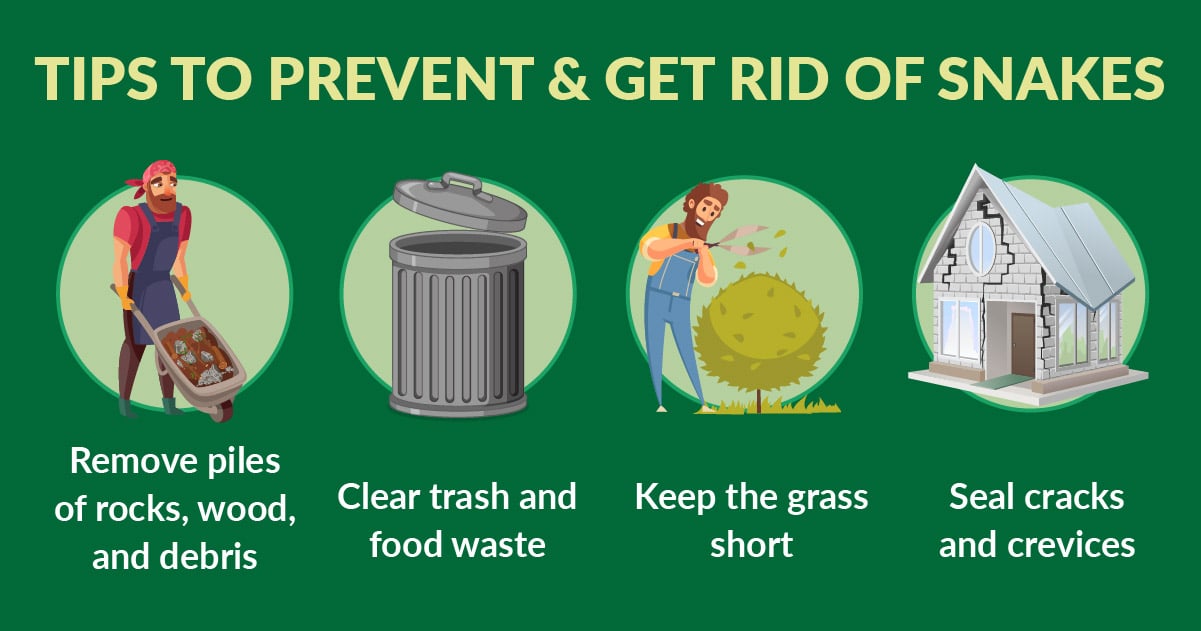
How to Prevent Snakes from Invading Your Home
1. Remove piles of rocks, wood, and debris
Piles of rocks, wood and debris serve as the hiding places of snakes and their prey. Maintain good housekeeping and keep your house free from debris to help prevent infestations of snakes.
Clutters and piles of debris provide ideal hiding and breeding sites for animals such as rodents, which serve as a food source for snakes. Snakes can also seek shelter among the clutter as they provide protection from predators and harsh weather conditions.
2. Clear trash and food waste
Although snakes are predators and do not feed on human food waste, food waste attracts pests like rodents. Rodents, in turn, are food sources of snakes. Waste bins should be covered. Food waste should be properly disposed of to prevent rodents from gaining access to the food, as this can cause rodent infestations, and subsequently, snake infestations.
3. Keep the grass short
Not only does grass attract mosquitoes, but it also attracts snakes. Long grass provides the perfect cover for snakes to hide from their predators and sneak up to their prey. Snakes are found in a variety of colours and patterns that they use as camouflage. The presence of long grass further facilitates snakes to blend in with the surroundings.
4. Seal cracks and crevices
Cracks and crevices are the hiding spots for pests, including snakes. Cracks and crevices provide shelter for snakes and protect them from threats present in the surrounding environment. Snakes can also enter your house from the surroundings through cracks or holes. Do look out for all potential entry points, cracks and crevices around your home. Make sure to seal them to avoid harbouring snakes and other pests in your house.
DIY Methods to Prevent Snakes in Singapore
Instead of trying out various methods to repel snakes, you can try to maintain good housekeeping around your house to keep snakes away from you. Sealing all the potential entry points and hiding sites mentioned above will help to prevent snakes from entering your home.
DIY Methods to Prevent Snakes in Singapore
Instead of trying out various methods to repel snakes, you can try to maintain good housekeeping around your house to keep snakes away from you. Sealing all the potential entry points and hiding sites mentioned above will help to prevent snakes from entering your home.
Professional Snake Removal in Singapore
Snakes can be aggressive when provoked or frightened, so you should never attempt to approach them when you see a snake. Avoid confronting or attacking a snake with a stick or broom as it may still be able to injure you. If you ever get bitten by a snake, it is important to try to stay calm and seek immediate medical attention.
You might have probably seen someone sucking out snake venom from a victim in a movie scene. However, in reality, it is almost impossible to suck the venom out as it spreads quickly and efficiently in the lymphatic system. The best thing to do if you ever get bitten by snakes is to minimise movement and call a doctor or an ambulance immediately.
In short, handling snakes on your own is not a good idea. Seeking help from professionals is the right way. Here, at Killem Pest, our Pest Management Professionals (PMP) are specially trained and licensed to carry out the removal of snakes.
With the recent enforcement of the Wildlife Act in Singapore, special courses and training were prepared for people involved who deal with wildlife removal activities. Our PMPs have attended the training and are certified professionals who can remove wildlife if needed, including snakes. Our professionals also advise you on the dos and don’ts when encountering a snake.
Frequently Asked Questions
There are 7 species native to Singapore that are considered highly poisonous: the King Cobra, Black Spitting Cobra, the Banded Krait, Banded Coral Snake, the Malayan Blue Coral Snake, and the Wagler’s Pit Viper.
Venomous snakes can be identified by the shape of their head: a triangular head is a sign that a snake is venomous. If its tail is rattling, it’s venomous. In any case, it’s best to stay away from any snakes.
Snakes are often attracted to yards and houses when there’s food or shelter for them. This can include leaf piles, gaps or cracks in your house, composting near the house, or else. Feeding pets outside, birdfeeders, or mulch can also draw snakes to your yard.
Related Posts
Nothing found.
The Complete Guide to Flies Prevention, Treatment and Control in Singapore
Flies are present around us. Their presence can cause severe problems to some people, such as the owners of food and beverage outlets. Besides food, flies are attracted to other materials such as rubbish, faeces, and decaying materials.
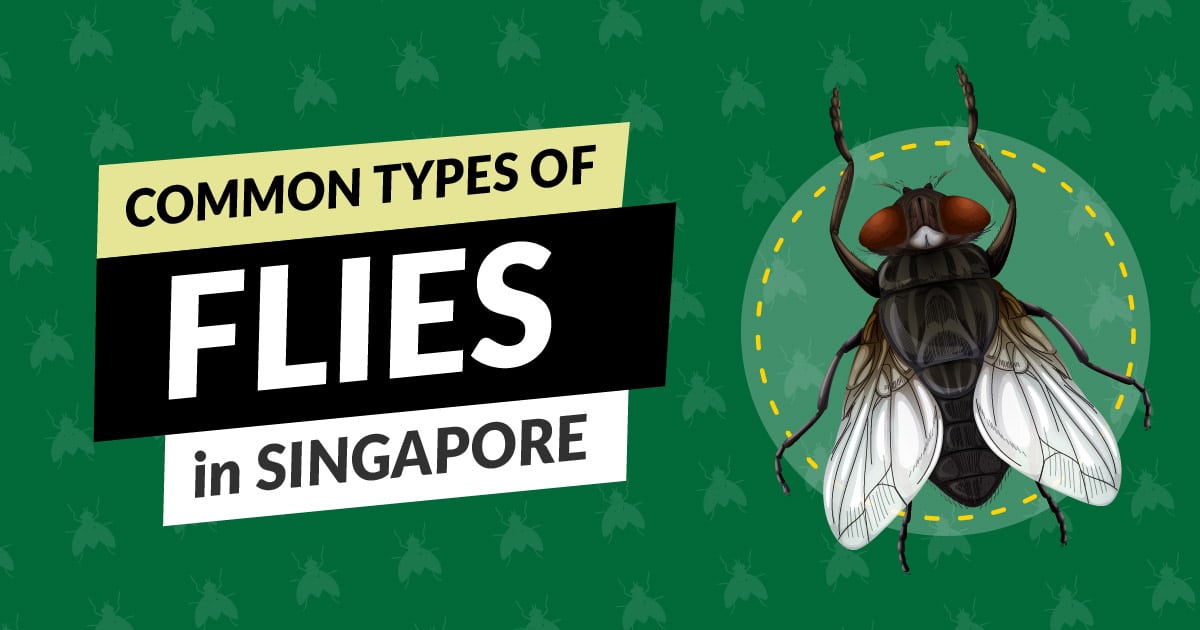
Types of Flies in Singapore
- Housefly (Musca domestica)
- Fruit fly (Drosophila spp.)
- Bluebottle fly (Calliphoridae)
- Flesh fly (Sarcophagidae)
- Drain fly (Psychodidae)
- Phorid fly (Megaselia)
Housefly (Musca domestica)
The houseflies are probably the most notorious species of flies. They can be recognized by the presence of four vertical stripes on their back and their grey colour body. Houseflies are usually found near the waste collection area, such as waste bins and bin centres, as they feed on food waste as well as excretory waste. Their presence at homes is a nuisance to many homeowners.
Fruit fly (Drosophila spp.)
The fruit fly is another species of fly that is found around us. They are around 3mm in size, yellowish-brown, and most of them have red eyes which makes it easy to distinguish them. Fruit flies are attracted to
- Ripened fruits
- Vegetables
- Wine
- Liquor
Bluebottle fly (Calliphoridae)
The bluebottle flies have a distinct metallic-blue body and red eyes, with a body size ranging from 10mm to 14mm. They are often found flying around waste bins searching for food. Bluebottle flies are also attracted to the faeces and decomposing dead bodies of animals.
Most Common Types of Flies in Singapore
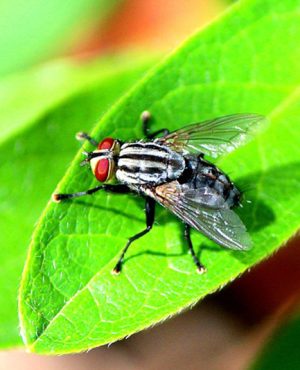
Flesh fly (Sarcophagidae)
Flesh flies are similar in size to bluebottle flies, but they have a grey body and can be distinguished by the three vertical stripes at the back of the thorax. Flesh flies breed on feces, dead bodies, and even open wounds (which their name implies).
Drain fly (Psychodidae)
The drain flies or sewer flies are also known as moth flies, as they have a fuzzy body that resembles moths. They are usually around 2mm and can be found around the sewage system, such as drains and floor traps which serve as their breeding sites. Drain flies feed on organic matter that is found in the sewers.
Phorid fly (Megaselia)
The phorid flies are another important fly species commonly found in Singapore. Due to their appearance, they are often mistaken to be fruit flies. Phorid flies breed in the drainage system as well as decaying materials, including plants.
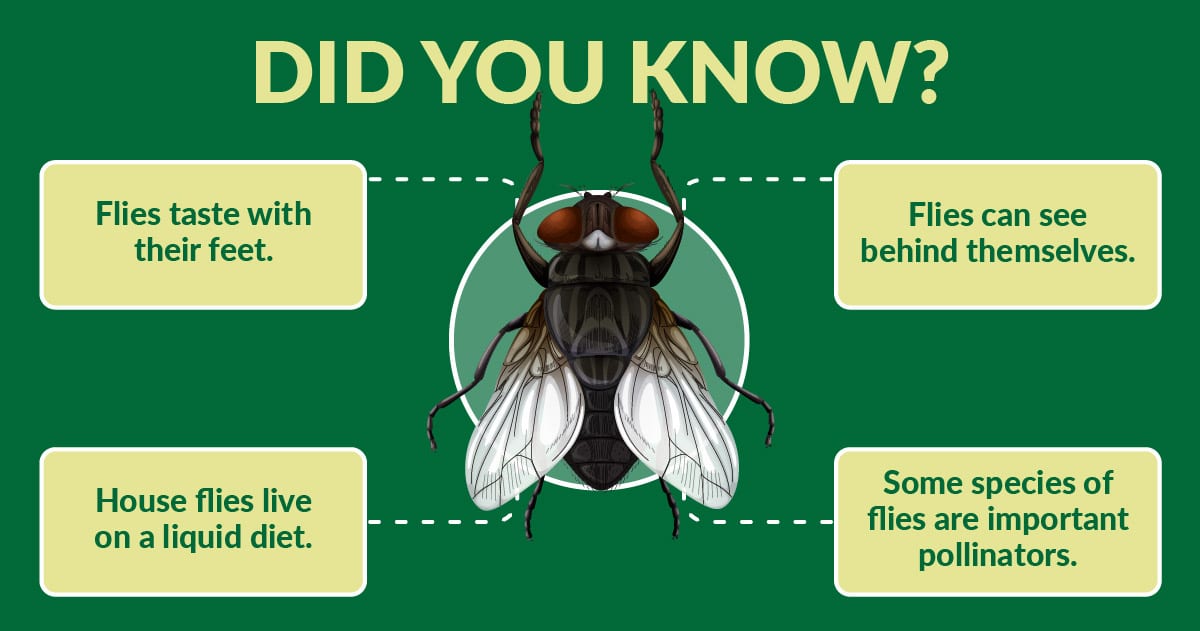
Life Cycle and Biology
Flies undergo complete metamorphosis, and their life stages consist of the egg, larval, pupal, and adult stages. The eggs differ in size and shape depending on the species. Generally speaking, they are laid on or near the larvae’s food sources, such as food waste in the case of house flies. The eggs hatch into larvae that resemble a worm. Some are commonly known as maggots. The larvae feed, store nutrients and gain energy. Then they turn into pupae before emerging as adults.
Did you know: The life cycle of a house fly only lasts for around 30 days, but in their short lifetime, they manage to lay up to 500 eggs.
Medical Importance
Flies are associated with poor sanitation and hygiene as well as the ability to transmit diseases. People dislike flies for these reasons.
Flies are mechanical vectors of diseases and conditions such as:
- Dysentery
- Diarrhoea
- Cholera
- Typhoid
- Salmonellosis
Flies pick up pathogens as they crawl and feed on infected surfaces with poor sanitation. They then transmit the pathogens to another object that they rest on, or through direct contact with humans. As flies feed, they regurgitate food, and this process facilitates the transmission of pathogens. The transmission of diseases can be prevented by avoiding unsanitised or contaminated cooking utensils and by making sure that food is not contaminated. It is important to keep flies away from food and utensils through proper storage and good housekeeping practices.
What Attracts Flies?
Flies have an excellent sense of smell. Studies have shown that certain flies can detect odours from up to 7km away. They can also detect odour from stains that are not visible to the naked eyes, making them highly efficient in searching for food. The presence of the following items may be the reason why flies are found around your house or premises:
- Food waste or decaying food
- Food stains
- Ripen fruits
- Sewer or drains
- Faeces or dead bodies of animals
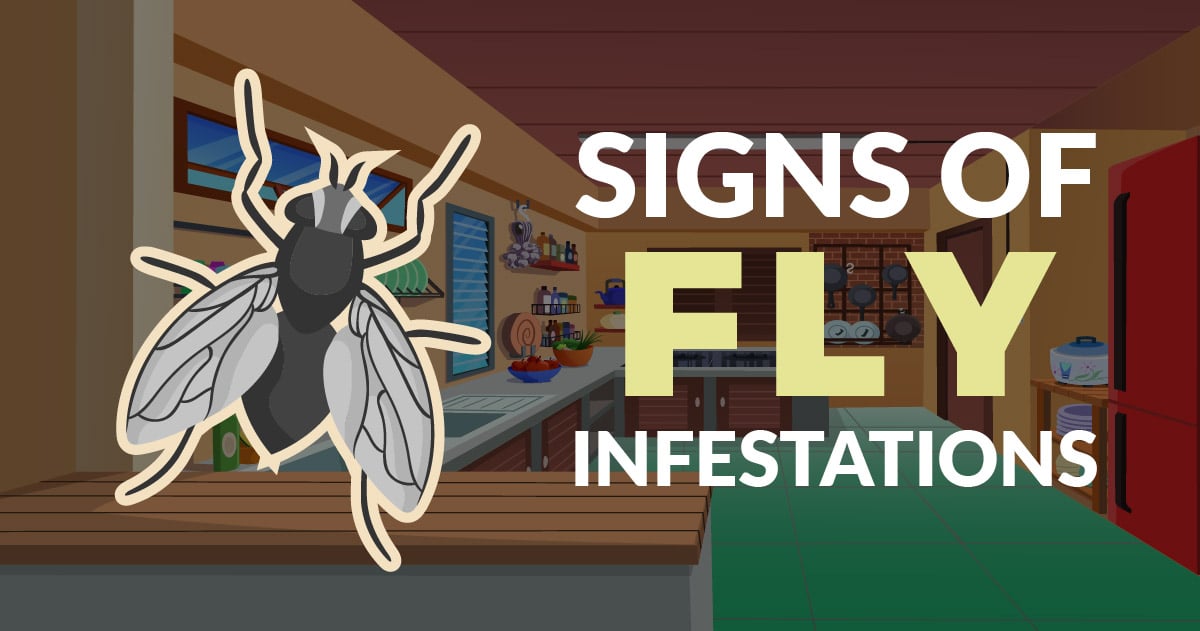
Signs of Fly Infestations
1. Sightings of flies around your house
It may be normal to occasionally spot flies around your house, as they may enter your home from the external while foraging for food. However, if you have seen flies around your house frequently or if you are noticing an increase in the number of flies, you may want to start looking for breeding sites for flies.
2. Presence of maggots around the house
Besides seeing flies flying around, the sighting of maggots usually signals a fly infestation nearby, as they usually will not venture far from their breeding sites. Follow the trails of the maggots or search the nearby areas. You should then be able to locate the breeding sites of flies.
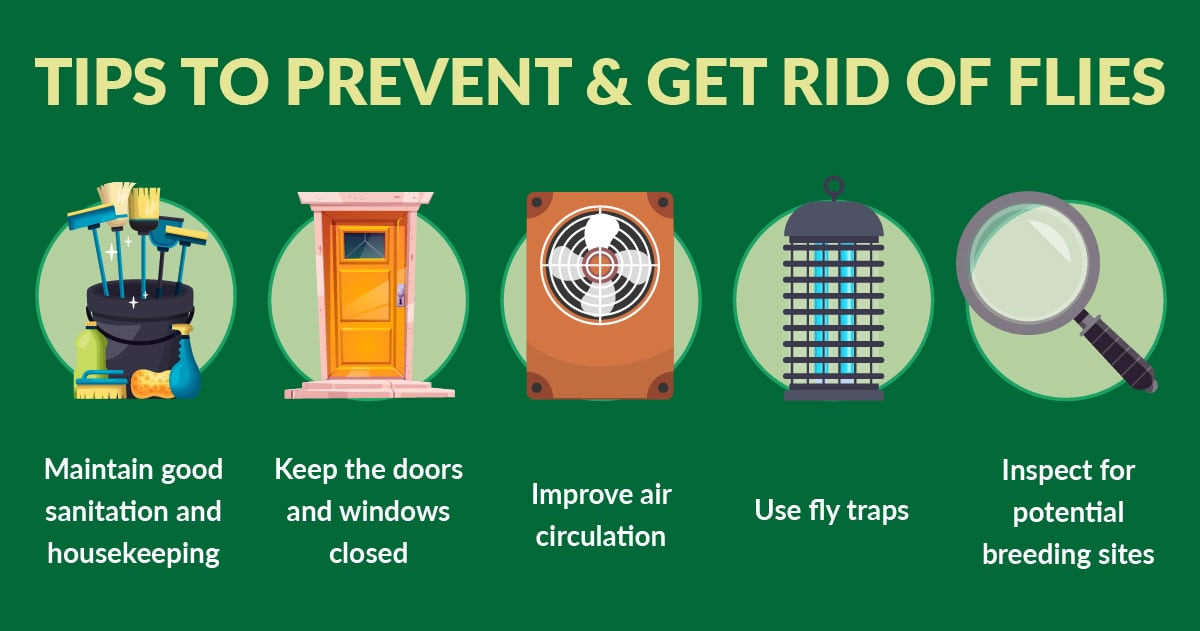
Tips to Prevent Flies From Invading Your Home
1. Maintain good sanitation and housekeeping
One of the most effective ways to keep pests out is by maintaining good housekeeping practices. Bad housekeeping and sanitation provide pests with sources of food, water and shelter, thus attracting them. Here are some important actions to take note of to keep flies away from home.
- Cover food. Flies have excellent olfactory senses, so the smell of food can attract them from afar. Properly covering food will prevent you from sharing food with flies and avoid contamination of food.
- Cover bins and empty them regularly. The kitchen bins and dustbins are where the food waste and leftovers end up. Flies are not as picky as humans, so the bins are great places for them to look for food. Covering the bins with lids will prevent flies from gaining access to food. Regularly emptying the bins will help avoid the accumulation of rotten food that attracts flies.
- Wipe and clean properly. Flies can feed on human food stains and grease. Thus it is important to keep the surfaces of food preparation areas and dining areas clean. Flies can detect stains or chemicals that are not visible to the human eye. Therefore, it is important to clean and wipe the kitchen. Cleaning properly will remove any materials that may attract flies. Do not let the dishes sit in the sink for too long, as the stains can also attract flies. Cutlery and utensils should be cleaned as soon as possible after use to avoid attracting flies.
- Keep drains clear. The accumulation of organic materials in drains form the ideal breeding sites of drain flies and even phorid flies. To prevent the breeding of drain flies, it is essential to make sure the drains are not clogged. Drains can be cleaned using drain cleaners or even hot water to remove the build-up of organic materials.
2. Keep the doors and windows closed
You can keep flies out by keeping the door and windows of the kitchen closed. Installing insect screens is another feasible alternative as it can keep flies out without making your kitchen and your home stuffy. Air curtains use fast-moving air to create a barrier that prohibits flies from passing through.
3. Improve air circulation
The movement of air disrupts the flight of flies, especially the smaller species, as they are weak fliers. Keep air circulating inside the kitchen by switching on the fan. This helps keep flies away.
4. Use fly traps
Flytraps are effective tools that are widely used in the control of flies. However, the use of fly traps with zappers is not recommended in the kitchen or dining area as they tend to break flies into pieces. Those body parts may fall into the food.
5. Inspect for potential breeding sites
Carry out regular inspections around your house or pay extra attention to the surroundings to spot the breeding sites of flies. Fix any cracks or building defects to prevent the breeding of pests, including flies. Early detection of fly activities will prevent the situation from escalating.
DIY Methods to Prevent Flies in Singapore
There are many types of homemade fly traps that are effective against flies. One of the easiest ways to make a fly trap involves using a bottle or jar and a cover or lid, apple cider vinegar, and dishwasher liquid. The trap is prepared by mixing one tablespoon of dishwasher liquid with apple cider vinegar in a bottle or jar. The bottle or jar is then covered correctly. A small hole is made on the cover as an entrance for the flies. This trap is effective against house flies and fruit flies as its scent will attract them.
Professional Flies Treatment
If you ever feel that the infestation is getting out of control, or if you wish to have peace of mind without worrying about flies infesting your properties, seek assistance from pest management professionals. Pest management professionals will design a management programme that is best suited for you to combat flies.
The first step of professional flies treatment involves thorough inspection to obtain information such as the severity of the infestation and identifying the source of the infestation. At Killem Pest, our pest management professionals (PMP) are professionally trained and updated with knowledge of pests. The PMPs will be able to determine suitable management programmes based on their evaluation. They can also identify breeding sources that may not be discoverable to ordinary people based on their experience in the field.
As mentioned earlier, fly traps are essential tools in fly management. The fly traps used by Pest Management Professionals are the insect light traps that attract flies using ultraviolet (UV) light. The UV light traps used by the professionals emit rays of a specific wavelength which, in turn, attracts flies. The flies are then trapped by the glue boards placed near the light source. The placement and position of the light traps play an important part in determining the effectiveness of the flies control programme. Poorly positioned insect light traps are ineffective and may cause other hazards if not installed correctly. Our PMPs will determine the ideal locations for the deployment of traps based on the inspection carried out.
Another treatment method for flies involves residual spraying. Residual spraying should only be carried out at locations without food to prevent contamination of food with chemicals. Residual spraying can be carried out in areas where flies rest, such as on the walls. Residual spraying should be carried out while paying attention to the surroundings to limit human and pets’ exposure to the chemicals.
Are you having problems with flies in your properties? Contact Killem Pest now.
Frequently Asked Questions
The short answer: all flies are somewhat dangerous. Flies are known for spreading different pathogens and diseases, as they crawl and feed on infected surfaces with poor sanitation.
Flies get attracted to the smell of food waste or decaying food, food stains, ripen fruits, sewer or drains, and faeces or dead bodies of animals.
Prevent fly infestation by maintaining good sanitation at your home. To get rid of flies, you can use fly traps or consult pest management professionals about using chemical pesticides.
Related Posts
The Complete Guide to the Prevention, Treatment and Control of Fleas and Ticks in Singapore
Fleas and ticks are tiny pests that are capable of causing great problems to humans. They leave itchy bites with distinct bite marks on human skin.
Fleas and ticks are two different pests that are often mistaken with one another. Fleas have long and powerful hind legs that allow them to perform high jumps. Ticks, on the other hand, do not jump. They have four pairs of legs which make them part of the spider family (arachnids).
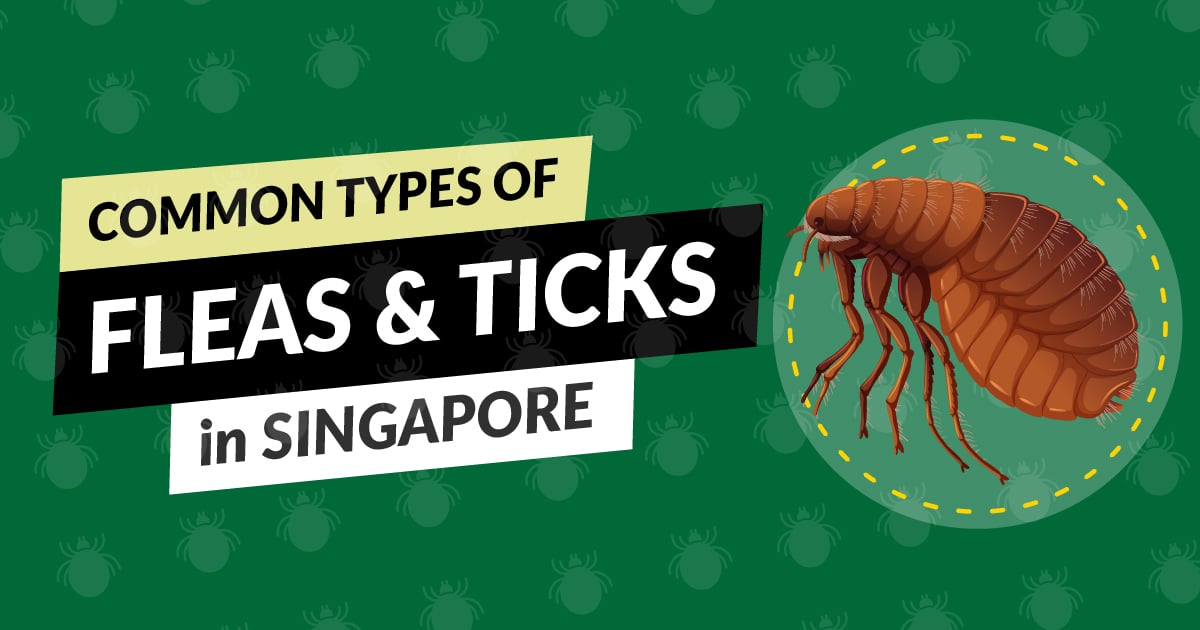
Types of Fleas and Ticks in Singapore
What are some of the common species of fleas and ticks found in Singapore?
Cat Flea (Ctenocephalides felis) and Dog Flea (Ctenocephalides canis)
Cat and dog fleas are the most common type of fleas found in Singapore. They can be found on pets, stray dogs and cats. However, despite their names, neither type of flea is exclusive to only cats or dogs. These fleas are usually 1-4mm in size. It isn’t easy to differentiate between the two species with the naked eye. Cat and dog fleas are excellent jumpers with the ability to reach 18cm vertically and 33cm horizontally, which is about 100 times their body length!
Dog Tick (Rhipicephalus sanguineus)
The brown dog tick is the species of ticks commonly found in Singapore. A dog can pick up ticks from the surroundings as ticks infest more than one host during their lifetime. The ticks can be found on the skin of the pets’ head, neck, ear and feet. In heavy infestations, the ticks can be found in nearby parts such as kennels or cages.
Oriental Rat Flea (Xenopsylla cheopsis)
Although the Oriental rat flea is not commonly found in Singapore, it is worth mentioning it. The Oriental rat flea is the vector for the bacterium that caused more than one of the deadliest pandemics in history. This flea type was responsible for spreading the bubonic plague, leading to the Black Death in the 14th century and killing over 25 million people.
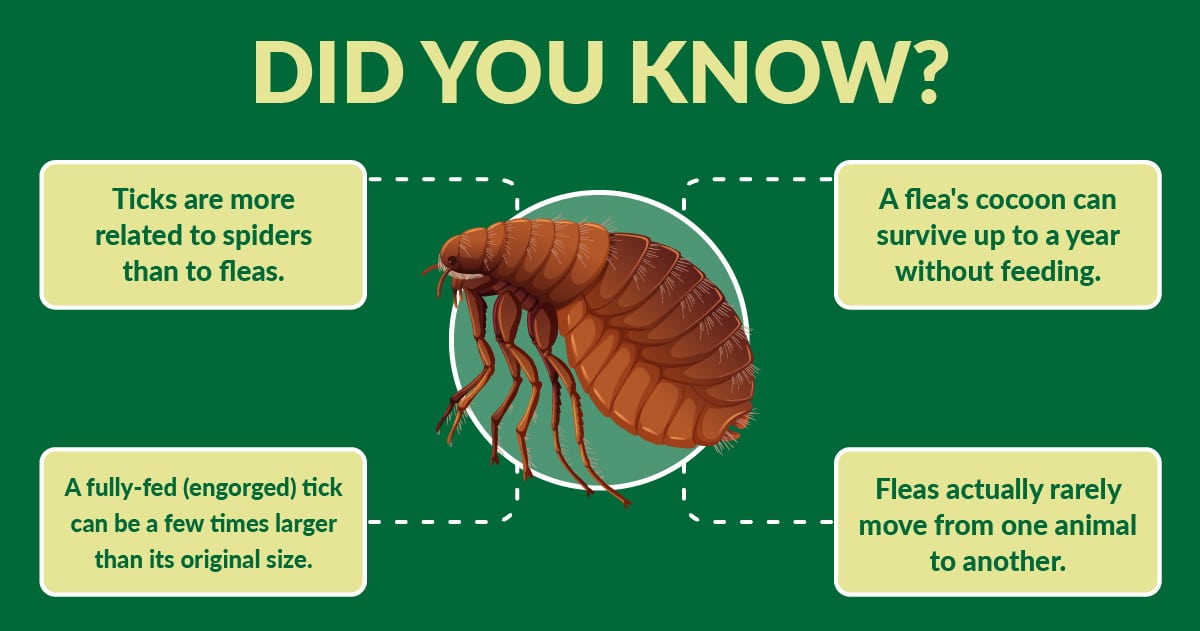
Life Cycle and Biology
Fleas undergo a complete metamorphosis. They go through the following stages of life:
- Egg
- Larvae
- Pupae
- Adulthood
Fleas have an average lifespan of 2 to 3 months. The fleas found on animals are always adults. Eggs are laid on the animal host’s body but will fall to places where the host rest, such as cages and cat baskets. The adults ingest blood from the host and produce faecal matters that become the food for the larvae.
Before turning into adults, the larvae form cocoons. The adults then emerge when stimulated by vibration, movement, or increased carbon dioxide (which indicates animal hosts’ presence).
The dog tick is a 3-host tick that encounters three hosts throughout its entire life span. The larva takes a blood meal and turns into a nymph. Then, the nymph feeds once before developing into an adult. An adult takes a blood meal before it lays eggs.
A female tick can lay an average of 4000 eggs. The number fluctuates with the amount of blood ingested. The host-seeking behaviour of a tick causes it to be seen in the open as it actively searches for a new host to latch on to. Ticks have a long life span and they can survive without feeding for 3 to 5 months.
Medical Importance
There are three common diseases associated with flea and tick bites:
- Murine Typhus
- Plague
- Lyme Disease
Murine Typhus
Murine typhus is a zoonotic disease caused by a bacterium known as Rickettsia typhii. There have been several reports of murine typhus in Singapore. Humans become infected when the site of a flea bite is exposed to the flea’s faeces, or by inhaling the bacterium from an environment contaminated with fleas’ faeces. Murine typhus is primarily transmitted by the rat flea, but cat fleas may also be one of the vectors.
Symptoms of murine typhus include:
- Fever
- Headache
- Stomach pain
- Nausea
- Vomiting
The disease can deteriorate to cause severe illness and damage to other organs, including the lungs, liver, kidney, heart and brain.
Plague
A plague is an infectious disease caused by a bacterium known as Yersinia pestis. Transmission of this disease is similar to that of murine typhus: through the bite of the infected fleas or by inhalation.
The plague is transmitted by oriental rat fleas and is most prevalent in Africa. Although the plague has claimed the lives of millions of people throughout history, today it can be treated with antibiotics and prevented with standard preventive measures.
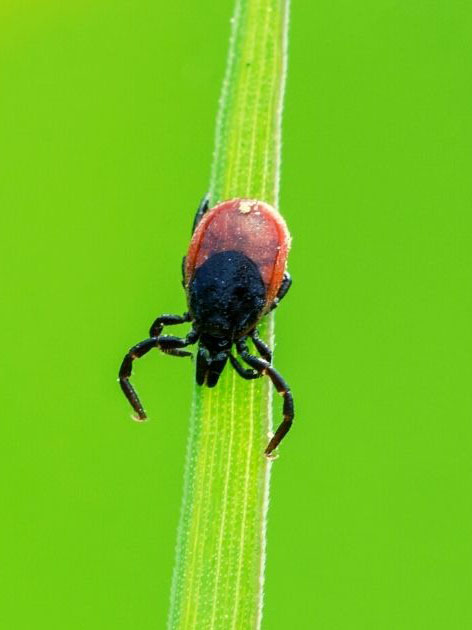
Lyme Disease
One of the major tick-borne diseases is Lyme disease. It is caused by the deer tick, which is not found in Singapore. Lyme disease’s most common sign is an expanding rash at the bite that may form a bulls-eye pattern.
If left untreated, the infection can spread and cause pain to the joints as well as cause neurological problems such as:
- Meningitis
- Temporary paralysis of one side of the face (Bell’s palsy)
- Numbness or weakness in limbs
- Impaired muscle movement
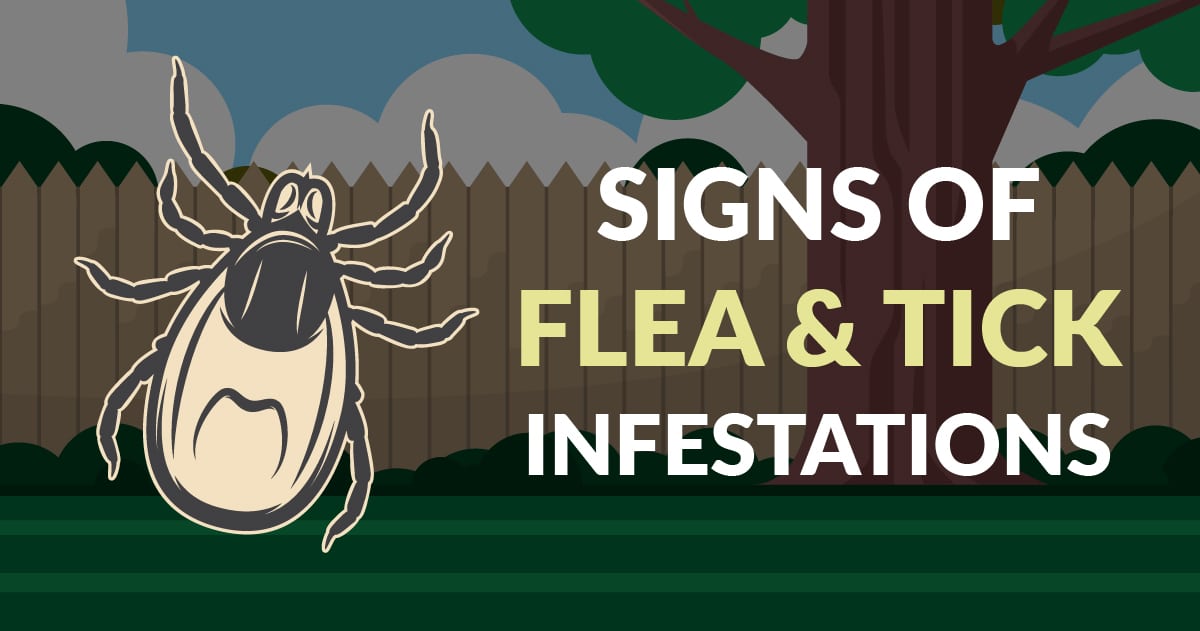
Signs of Flea and Tick Infestations
It might not be easy to detect fleas and ticks at home because of their small size and cryptic behaviour. Here are some signs that may indicate a flea or tick infestation.
1. Itching or infected skin
Even though they can feed on human blood, animals are the primary hosts of fleas and ticks. Your pets may have itching skin. Hence, they might scratch their skin or bite their skin more frequently than usual. Besides, symptoms such as hair loss and rashes may develop on your pets as the fleas or ticks bite and cause infections on their skin.
2. Finding them on or around your pets
Although fleas and ticks are difficult to spot, it is not impossible. They can be detected on your pets’ body when you comb their hair. Ticks and fleas can also be found around the cage or bedding where the pets rest. It is possible to see them moving around as they venture out away from their nests seeking a new host.
3. Bites
Fleas leave itchy bites on humans. Those bites are one of the most obvious signs of flea infestation. Flea bites are itchier compared to mosquito bites. The reactions that the skin develops from them are usually more severe and include:
- Rashes
- Hives
- Blisters
On the other hand, tick bites are usually not painful or itchy. However, they do leave red spots or bumps on the affected skin.
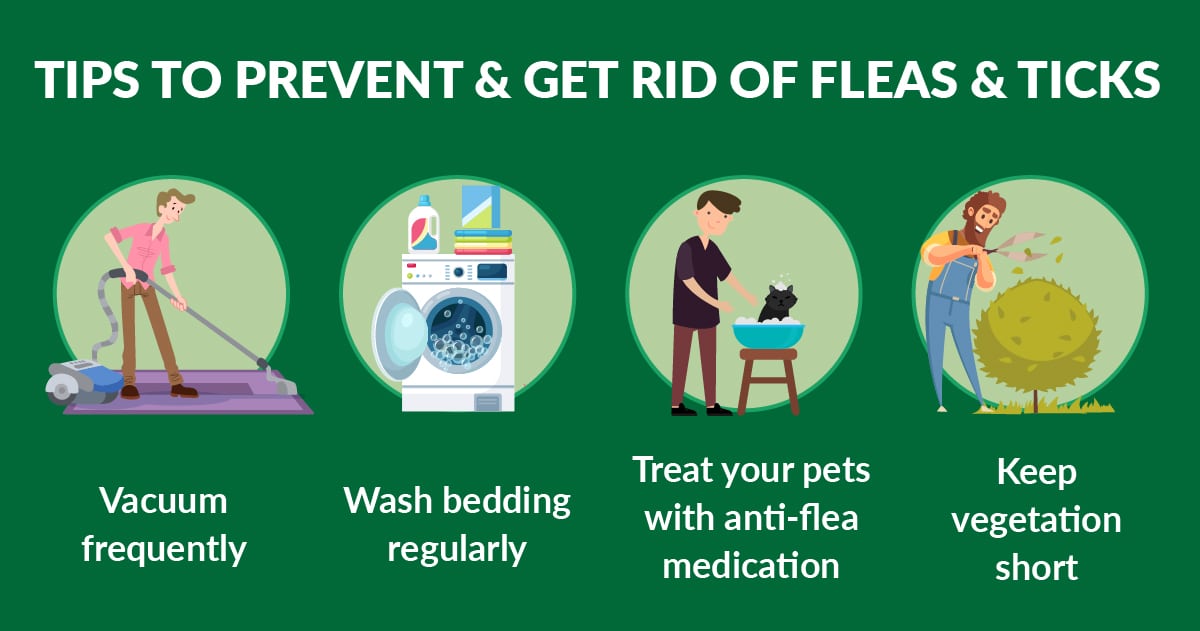
Tips to Prevent Fleas and Ticks From Invading Your Home
1. Vacuuming frequently
Vacuuming is not only a way to clean your house and remove unwanted dirt and dust. It also helps you prevent infestations of fleas and ticks. Vacuuming can physically remove the pests, their eggs and larvae. If you suspect that you have fleas or ticks at home, you should seal the vacuum bag and dispose of it properly after vacuuming. This ensures that the pests cannot make their way back into your home.
2. Wash bedding regularly
As mentioned earlier, fleas and ticks do not spend their entire lifespan on their hosts. They can sometimes be found nearby. Fleas and ticks can infest (pet) bedding. Bedding should be washed in hot, soapy water every two to three weeks to eliminate the pests.
3. Treat your pets with anti-flea medication
Flea medications can not only be used to treat an existing infestation of fleas. It can also be used for prevention. There are medications taken orally by the pets and those that are applied topically onto the pets’ skin. Flea medications can be administered once a month to protect you and your pets from fleas.
4. Keep vegetation short
Ticks often climb onto grasses to increase their success rate of finding a new host. By keeping the vegetation short, you can prevent this from happening and reduce the hiding options.
DIY Methods to Prevent Fleas and Ticks in Singapore
Essential oils are known to have many benefits, including insect-repelling effects. Cedarwood essential oil can be diluted and applied to the pets’ skin to kill and prevent fleas. It can also be added to a diffuser to protect your house against fleas. Some essential oils, such as rosemary, can be added to the pets’ bath to provide long-acting flea repelling effects.
Pro Tip: Since it is impossible to know whether a parasite is potentially carrying any diseases, it is important to protect pets against all ticks and fleas.
Professional Fleas and Ticks Treatment
Chemical Treatment
Chemical treatment is the fastest and most effective method to eliminate an existing infestation. The insecticides that we use are safe for pets. All our PMPs are trained to carry out the treatment by following proper procedures.
Habitat Modification
Based on the inspection carried out at the infested premises, our PMP will provide house owners with recommendations to prevent flea and tick infestations in the future. Building defects such as cracks and crevices may be discovered during the inspection. Hence, our PMP will provide advice on how to solve the deficiencies.
Advice
After identifying the problem, our PMP can provide you with more information (if needed) so that you can seek advice from medical professionals and veterinary experts.
Inspection and identification
Inspection is an essential step in any pest management approach. It helps Pest Management Professionals (PMP) identify the cause and level of infestations. By identifying the pest species causing the issue, PMPs in Singapore can plan suitable control measures to handle the situation.
Frequently Asked Questions
Both fleas and ticks can spread diseases and cause harm to humans, however, ticks are more dangerous as they can spread deadly diseases.
Yes, fleas and ticks can transmit diseases to humans, the most common of which are murine typhus, plague and Lyme disease.
Vacuuming, steam cleaning and washing beddings in hot water can help to prevent fleas and tick infestations. Flea medications can be used to treat and prevent flea infestations in pets.
Related Posts
Nothing found.
The Ultimate Guide to Cockroach Prevention, Treatment and Control in Singapore
Cockroaches have been around on earth for more than 300 million years. They are one of the most common insects infesting households. There are more than 4500 cockroach species in the world, but less than 1% of them are known as pests.
Most cockroach species are in the wild. The ones that are associated with human habitats are classified as pests. Cockroaches play essential roles in the natural ecosystem. Some people even regard them as pets.
But mostly, cockroaches are described or depicted as disgusting creatures. Their existence often gives an indication of dirt or decay. The presence of it in food and beverage outlets poses health issues. In fact, it is very rare to encounter someone who sees a cockroach as an adorable or lovable insect.
Most people who live in urban or city areas cannot withstand the existence of a cockroach infestation in their house. Some may even get depressed. Indeed, controlling cockroaches requires knowledge and technique. Here we will look at the signs of a cockroach infestation before making a treatment decision.
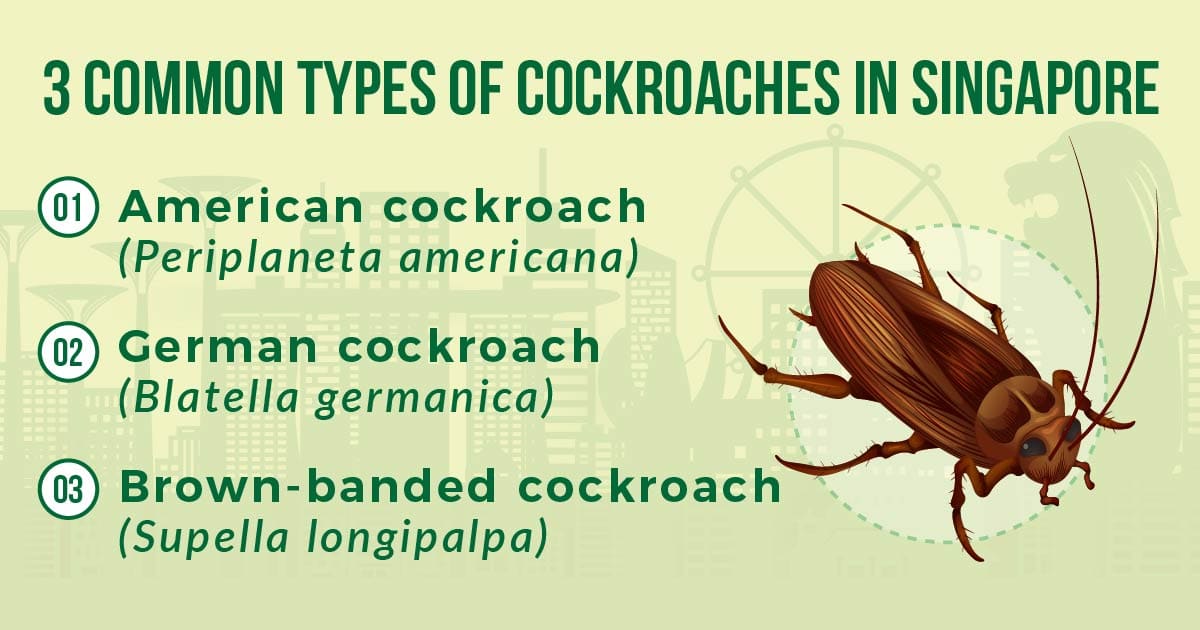
Types of Cockroaches in Singapore
As mentioned earlier, only less than 1% of cockroach species are pests. Here are three species commonly found in Singapore:
- American cockroach (Periplaneta americana)
- German cockroach (Blatella germanica)
- Brown-banded cockroach (Supella longipalpa)
American cockroach
The American cockroach may be the most commonly seen cockroach in Singapore. It has a reddish-brown body and a yellow band at its pronotum (plate-like structure behind the head). The size of an American cockroach can reach up to 40 to 50mm in length. American cockroaches are active both indoors and outdoors as they infest the sewer system.
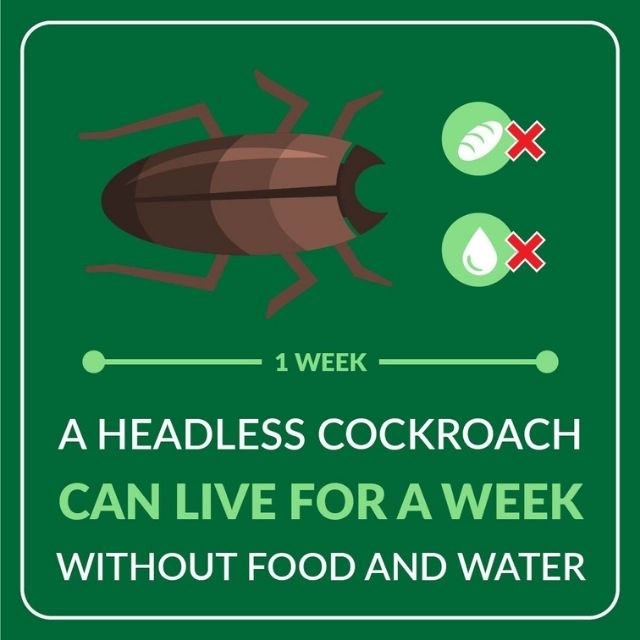
German cockroach
German cockroaches are around 20mm big. They have a light brown or tanned colour. Adult German cockroaches can be recognised by the two dark stripes on their back.
These are some places where you’ll commonly find German cockroaches:
- Indoors
- Kitchen
- Food preparation areas
Large German cockroach infestations cause nightmares to owners of restaurants and F&B outlets. The control strategies for this species is more challenging compared to the other species. This is due to the development of insecticide resistance and its high reproductive rate.
Brown-banded cockroach
The body size of brown-banded cockroaches is similar to that of German cockroaches. The males are light yellowish or brown, while the females have a darker colour. The brown-banded cockroach gets its name from the transverse stripes that are present on its body. This species is also responsible for cockroach infestations in homes and offices.
Life Cycle and Biology
Cockroaches undergo incomplete metamorphosis. They develop from egg and a few instar stages to adulthood. Newly emerged nymphs are miniature wingless adults. They will need to moult several times to reach the adult stage. Different species of cockroaches will have varying development periods and amounts of moults.
In common areas, they prefer to move or venture along the side of the wall. An interesting thing about cockroaches is that they feed on almost every organic material, preferably starchy food. They can feed on moist cardboard and even a piece of paper! Cockroaches are often reluctant to forage food far from their nesting area unless being deprived.
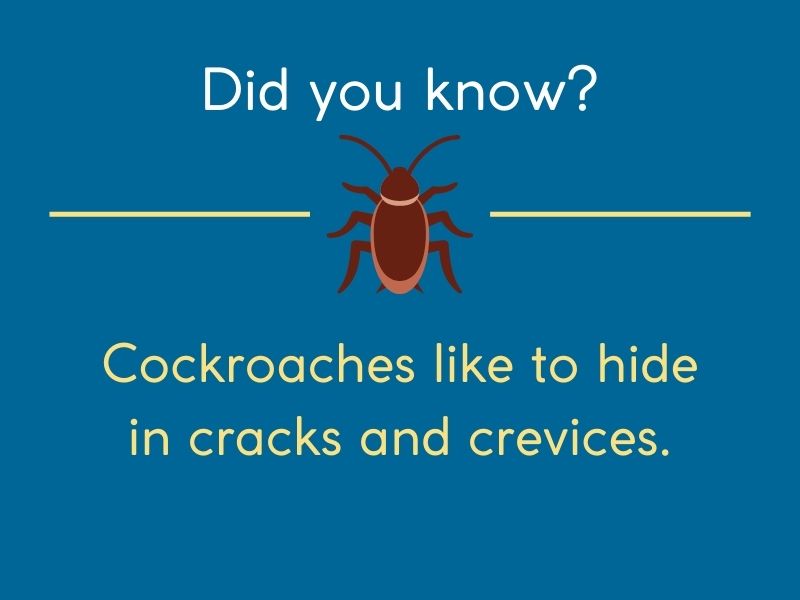
Medical Importance
Mechanical vectors of diseases
The living and feeding habits of cockroaches are commonly associated with poor hygiene and sanitation. This exposes them to a wide range of pathogens. They pick up the pathogens with their body and legs and transmit them to food, kitchen utensils and food preparation areas as they crawl past the surfaces.
Cockroaches are known to carry pathogens that cause diseases such as:
- Food poisoning
- Salmonellosis
- Cholera
The pathogens are invisible to the naked eyes so we must eliminate their vectors to avoid being infected by them.
Asthma and allergy
The body parts, excretory waste and even saliva contain allergens that may trigger allergic reactions. Typical allergy symptoms include:
- Sneezing
- Coughing
- Nasal congestion
- Wheezing
- Skin rash
Cockroach allergies are a common cause of asthma in both adults and children. If you have a cockroach infestation at home, you are at risk of developing prolonged allergic reactions that may lead to other medical problems.
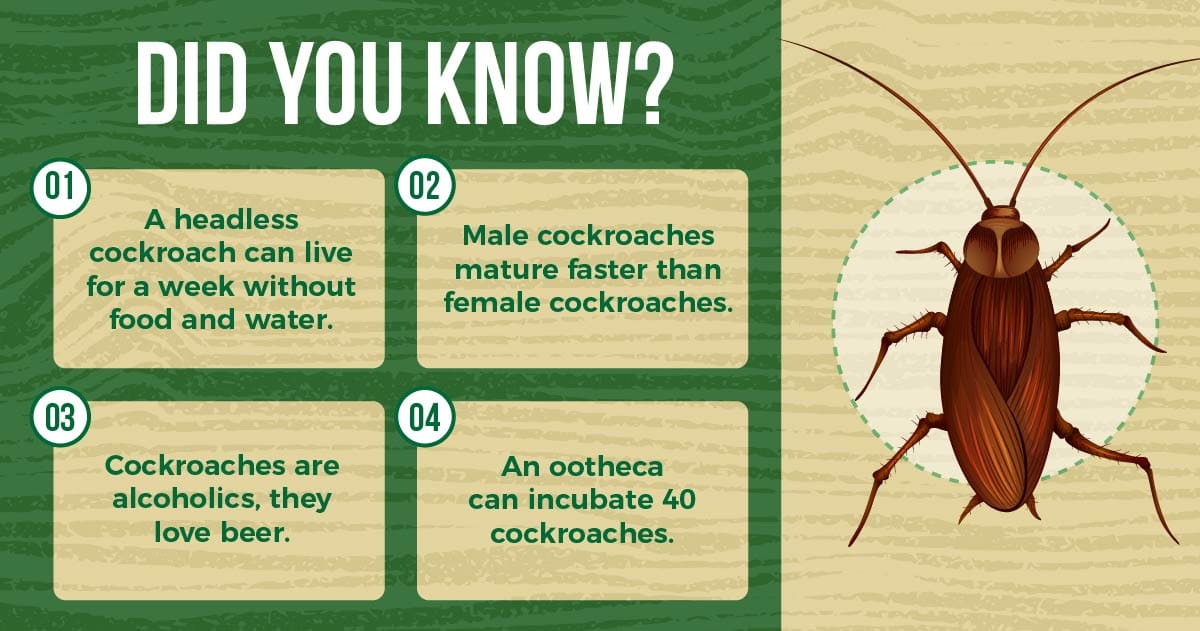
Katsaridaphobia
Katsaridaphobia, more commonly known as cockroach phobia, is the irrational and extreme fear of cockroaches.
Katsaridaphobia is not the same as being disgusted after seeing a cockroach. People with katsaridaphobia have unwarranted fear towards cockroaches that may cause them to:
- Stay frozen
- Have an elevated heart rate
- Have difficulty breathing
- Get panic attacks
One of the causes of katsaridaphobia is a bad or traumatic experience with cockroaches in the past. Katsaridaphobia is a mental disorder that can be overcome via psychotherapy, such as exposure therapy and cognitive behavioural therapy.
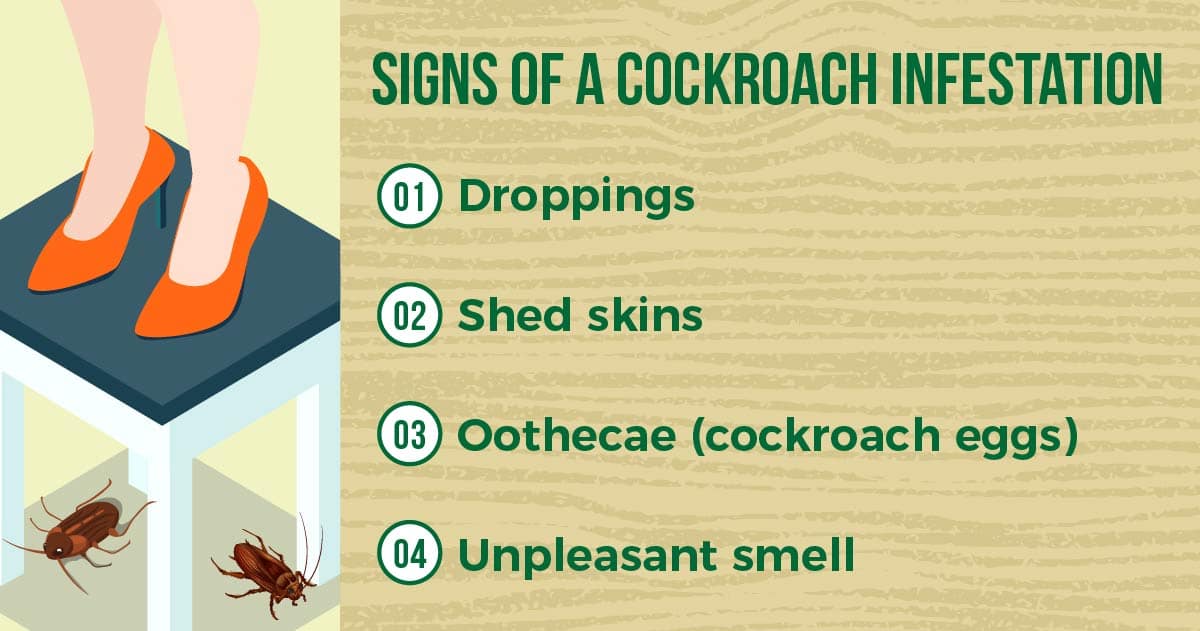
Signs of Cockroach Infestations
Cockroaches are nocturnal insects, most active at night. During the daytime, they hide in dark and moist areas. Hence, we often don’t notice their presence until the infestation becomes severe. Here, we’ll describe the tell-tale signs of a cockroach infestation.
1. Droppings
You may wonder how cockroach droppings look like? Cockroach droppings look something like black pepper with a dark colour and cylindrical shape. Their droppings are usually scattered along the wall or at the corners and edges of the cabinets. These are their main pathways and hiding areas.
2. Shed skins
Cockroaches molt just like other insects. Molting is a step in their growing process to reach the mature stage. Therefore, they will need to shed their skins periodically, around 5 to 8 times. If you see brownish shed skins at the potential areas mentioned above, that’s probably the evidence of a cockroach infestation.
In such case, you must start taking controlled action against them. The best way to prevent them from harboring is by keeping your house clean. Other aspects such as techniques of storing food and structural defects inside a property cannot be neglected.
3. Oothecae (cockroach eggs)
Oothecae are oval-shaped casings (inside full of multiple eggs), which are bigger and much more evident than cockroach droppings. It is vital to remove the ootheca before it hatched. The hatching of one cockroach ootheca can worsen a cockroach infestation.
A scary fact is that one ootheca can incubate more than 20 cockroaches inside!
Therefore, if you find an empty ootheca in your house, you may have to accept the fact that cockroaches have already built its family inside your home.
4. Unpleasant smell
Do cockroaches carry a smell? Yes! The scent released by a cockroach is usually undetectable by human beings. However, when it comes to a major cockroach infestation, a musty odour can be present. The smell is considered stinky for most people but when it comes to cockroaches, it carries important means!
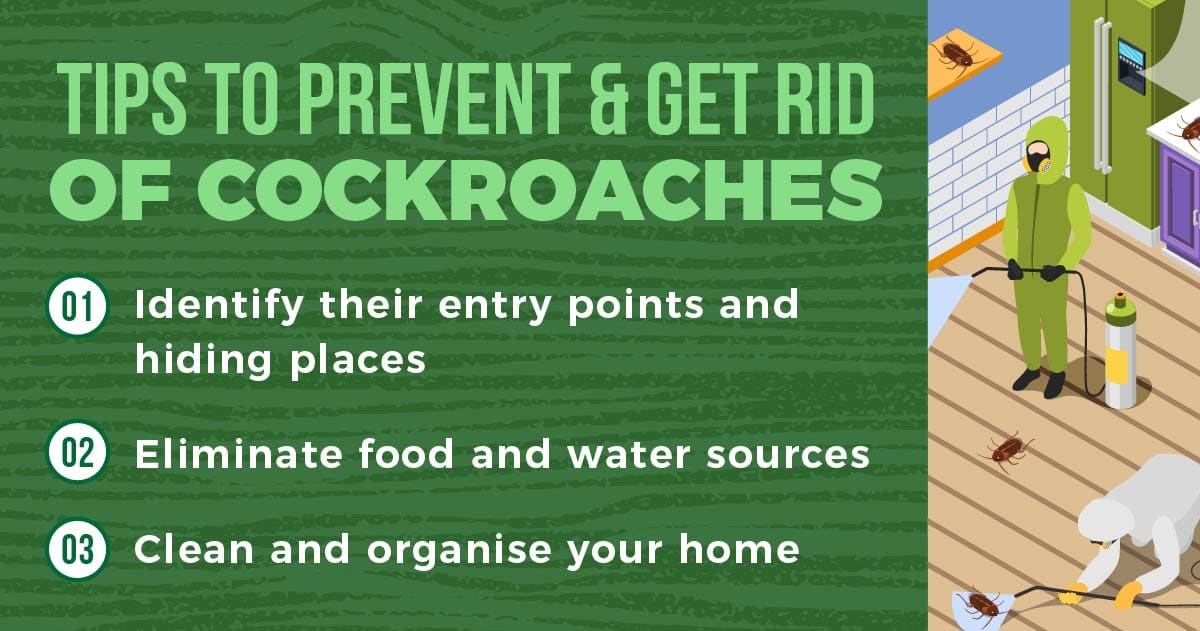
How to Prevent Cockroaches from Invading Your Home
1. Identify their entry points and hiding places
Inspection is a key activity in identifying the entry points and hiding places of cockroaches. Since cockroaches are nocturnal insects, it would be best if the inspection is carried out at night. Get yourself a torchlight and search for signs of their activities as mentioned above.
Cracks, crevices or gaps formed around the utility line and pipes are their potential entry points. Silicone-based caulk can be used to seal those entry points found. Besides, remember to inspect, clean and ventilate areas underneath the kitchen sink and refrigerator as these are the humid places that can become cockroach harbourages.
2. Make the Infested Area Less Conducive
After the inspection, keep in mind to remove, vacuum or wipe areas where cockroach eggs (ootheca), droppings and their carcasses were found. Remember one egg case can harbor 20 cockroaches inside, so remove it before it hatches to prevent a cockroach infestation.
You might not believe that cockroaches eat their own or nestmates’ droppings. Female cockroach droppings were seen highly attractive to nymph. The droppings also release pheromone (a chemical substance used to affect cockroach behavior and physiology).
3. Eliminate food and water sources
Food and water are the primary necessities of cockroaches. One of the best ways to prevent cockroaches from entering your property is to remove all available water sources.
Maintaining the housekeeping of the house is vital. We cannot forget to clean stains, grease and food scraps left in the kitchen as these can act as the food and water sources for cockroaches. Furthermore, make sure all stored food is sealed correctly to deny access.
Cockroaches can squeeze their bodies through a gap as small as 2mm wide.
In addition, some humid areas such as underneath the kitchen sink or refrigerator are potential nesting areas for cockroaches. So remember to inspect, clean and ventilate these areas to prevent a cockroach infestation.
4. Clean and organise your home
Messy and cluttered areas, especially those with paper and cardboards, are ideal harbourage and nesting sites of cockroaches. The paper products do not only serve as their hiding place. They also serve as food in case other food sources are not available.
It is essential to keep your home tidy and remove clutters regularly. The use of carton boxes for storage may allow cockroaches to hide in them. Thus, other alternatives, such as plastic boxes, can be used to prevent cockroach infestations.
5. Seek Professional Help
It would be an exhausting task to deal with a major cockroach infestation. Fear of cockroaches is the first barrier that most people will face. To deal with them, you may need to have plenty of time to fight. However, this is almost impossible for most people.
The short life cycle and high reproductive potential of cockroaches even make the control effort difficult. Hence, it would be easier to hand over this task to pest control professionals as they are more familiar with your enemy and has the best technique to manage the pest.
DIY Methods
Traps can capture and remove cockroaches from your home. The most common method is a sticky trap. These traps can be purchased from regular stores.
You may wonder about the effectiveness of using pandan leaves to prevent cockroach entry. Here, we tell you the truth. Pandan leaves release some pleasant smells which may serve as a weak natural repelling agent to deter cockroaches from coming near. However, when the leaves dried out, it can actually turn into a harbouring place for cockroaches! Hence, the use of pandan leaves is not a permanent solution for a cockroach infestation.
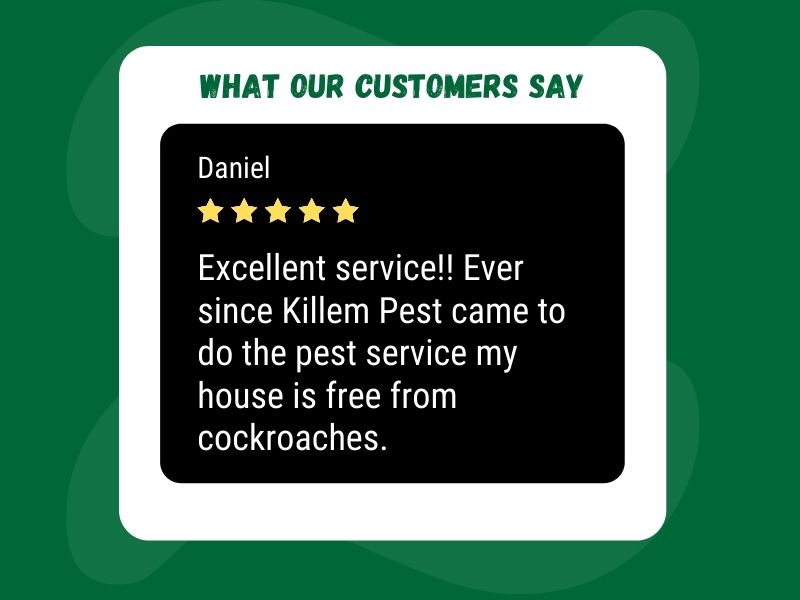
Professional Cockroach Treatment
Treating a cockroach infestation is more than just hitting them with your slippers or spraying insecticide aerosols on the cockroaches.
Insect monitoring stations are useful tools to detect the presence of cockroach infestations in Singapore. In premises with cockroach infestations, these stations can provide trained pest management professionals (PMP) with information such as the:
- Level of infestation
- Type of cockroach species
- Location of the nests or breeding sites
This information is important in determining a suitable treatment method. It has a tremendous impact on the effectiveness of the control programme.
Pro Tip: It is important to determine a suitable and effective treatment method depending on the type of cockroach infestation.
Residual spraying is the most common method used to eliminate crawling insects, including cockroaches.
The insecticides used in professional cockroach treatments are different from those available to the general public. Residual insecticides offer long-lasting protection against cockroaches. Its effect can last for months after application. Trained PMPs carry out residual spraying at locations where cockroaches are usually found, such as cracks and crevices.
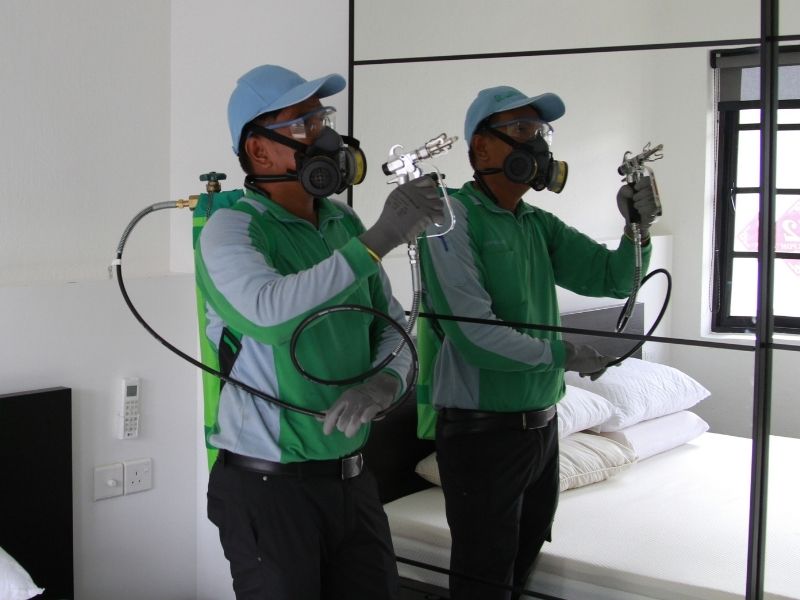
Cockroach baits combine insecticides with food attractants to kill cockroaches. The bait does not kill cockroaches immediately, but it intoxicates the cockroaches once they feed on the bait. The intoxicated cockroaches may leave behind their toxic vomitus, faeces or even their own dead bodies.
Cockroaches feed on the faeces and vomitus of their nestmates.
This behaviour, together with the cannibalising behaviour of cockroaches, makes the transfer of toxic bait effective and efficient as cockroaches move back to their nesting site and die off after foraging and feeding on the bait.
Innovation is important in the pest management industry to keep up with increasingly challenging pest issues. Pests, including cockroaches, are continually evolving and developing resistance to the control methods and insecticides that are used to eliminate them.
One of the latest cockroach treatment methods used in Singapore is dry treatment using Mirakn, a gas cylinder filled with a mixture of carbon dioxide and an active ingredient. There are three types of Mirakn treatments, each with different active ingredients that are suitable for targeting different pests.
The dry treatment has various characteristics. They are:
- Stainless
- Residue-less
- Non-flammable
- Odourless
Furthermore, the gaseous chemical provides excellent penetration over the other treatments. Dry treatment is a popular cockroach treatment in cars. Cockroaches thrive in cars, but it isn’t easy to control them due to the complex internal structures of the car.
Mirakn provides the ideal solution for hard-to-access areas as it can penetrate all parts of the treated area and leaves no stains. Thus, home and car owners need not worry about the cleaning process.
Killem’s team of pest management professionals are trained and experienced in cockroach treatment programmes. Our professional knowledge and experience enable us to formulate a suitable solution to protect your property from cockroaches.
Frequently Asked Questions
Cockroaches can contaminate your food and carry pathogens that can cause allergies, asthma, diarrhea, dysentery, cholera and other diseases.
Cockroaches can get into your house through open doors and windows, cracks and holes in your building, or through shared pipes and holes in the walls.
Cockroaches prefer dark, warm and moist places, so they usually hide in narrow cracks, behind refrigerators, near plumbing fixtures, in dark drawers or in and around running electrical appliances.
Make sure to close all possible entries for cockroaches, such as cracks and crevices in the walls. Another thing you need to seal and store food properly.
We have been dealing with cockroach infestations in Singapore since 1993. You can count on us to treat your pest problem effectively and swiftly.
You can get a free quote by submitting a quote request (click the GET A QUOTE button on top of the page).





